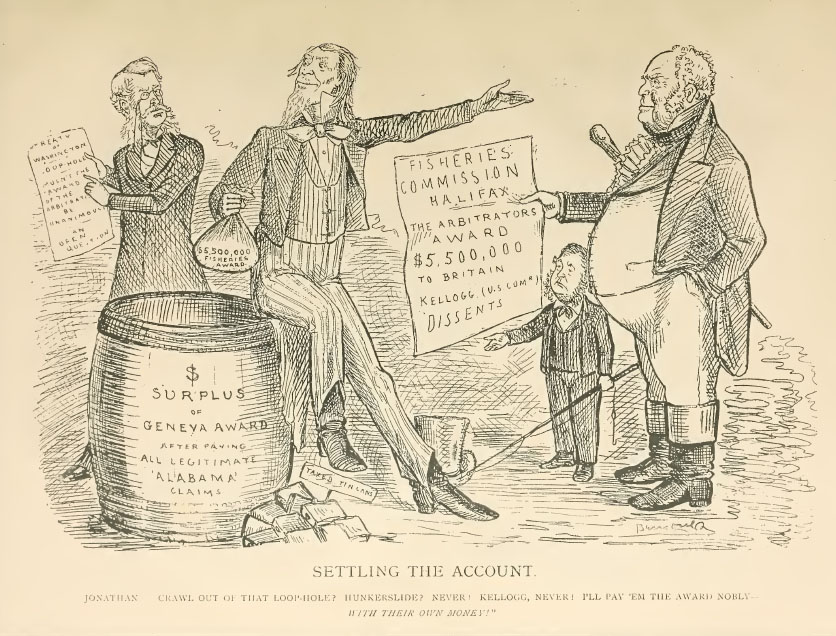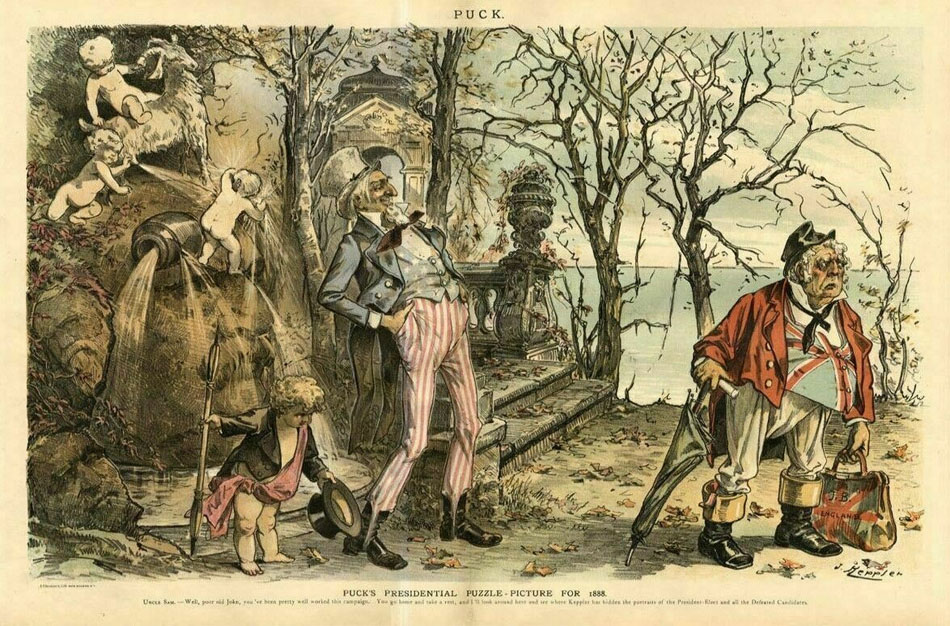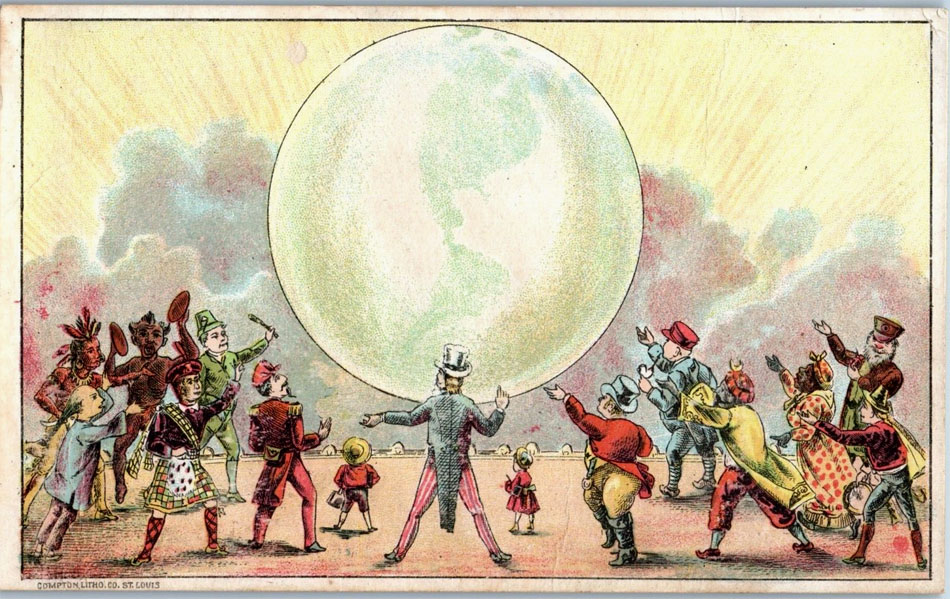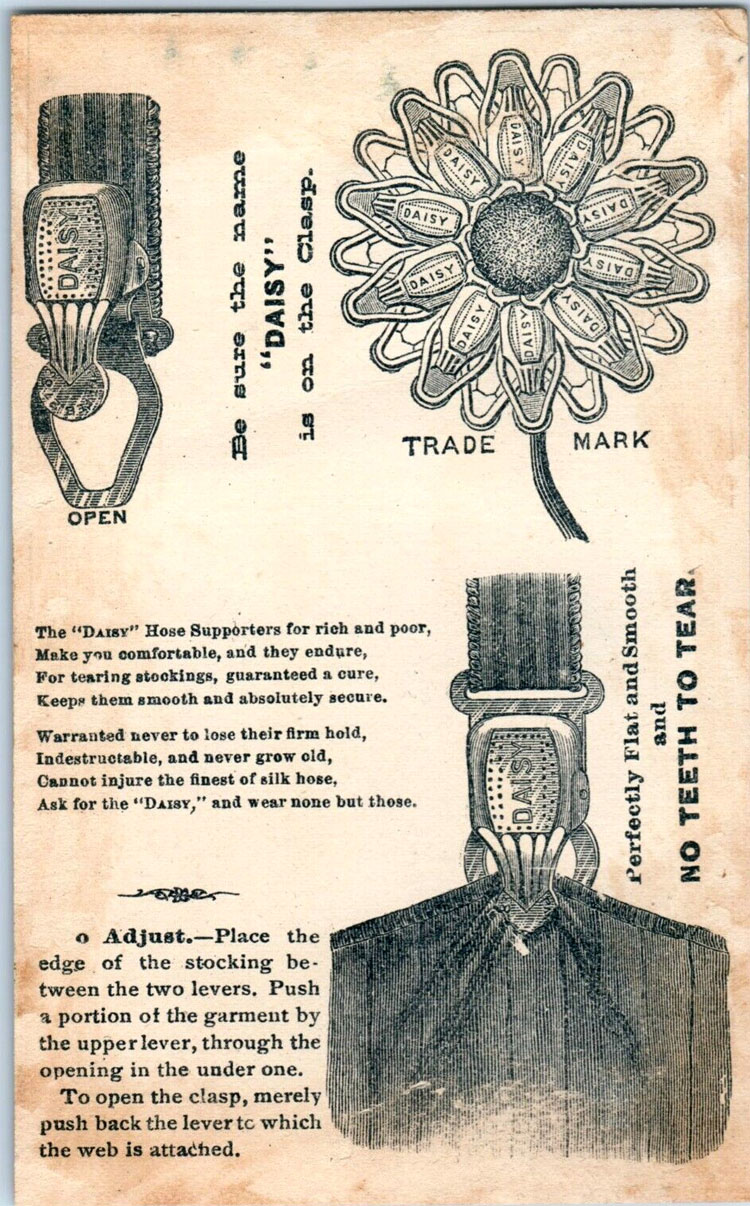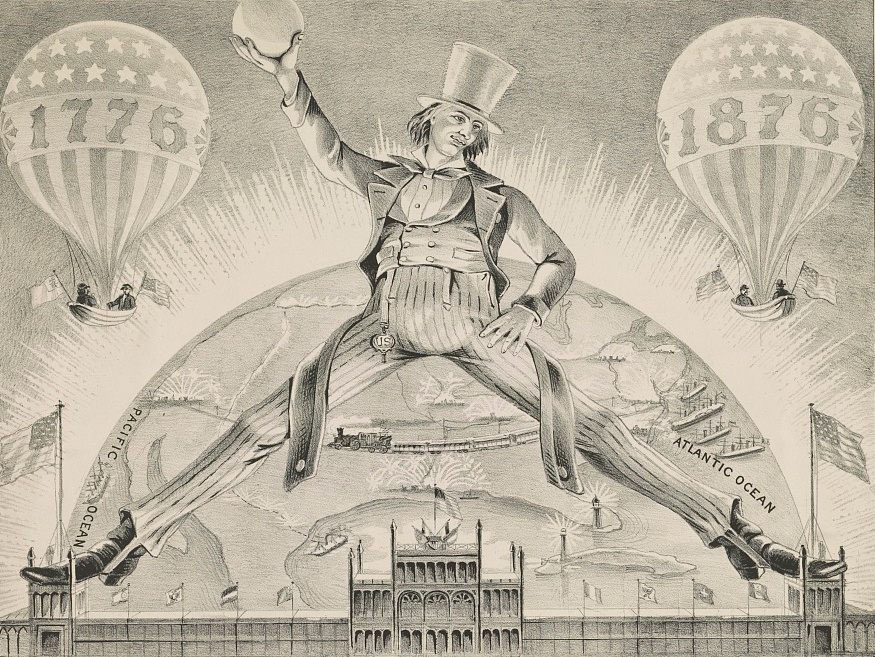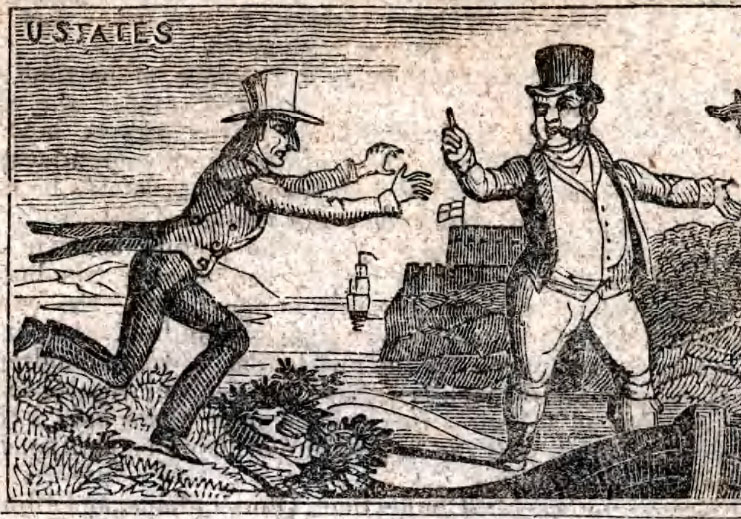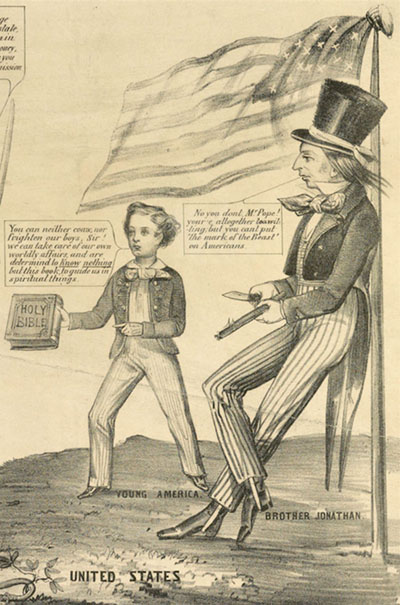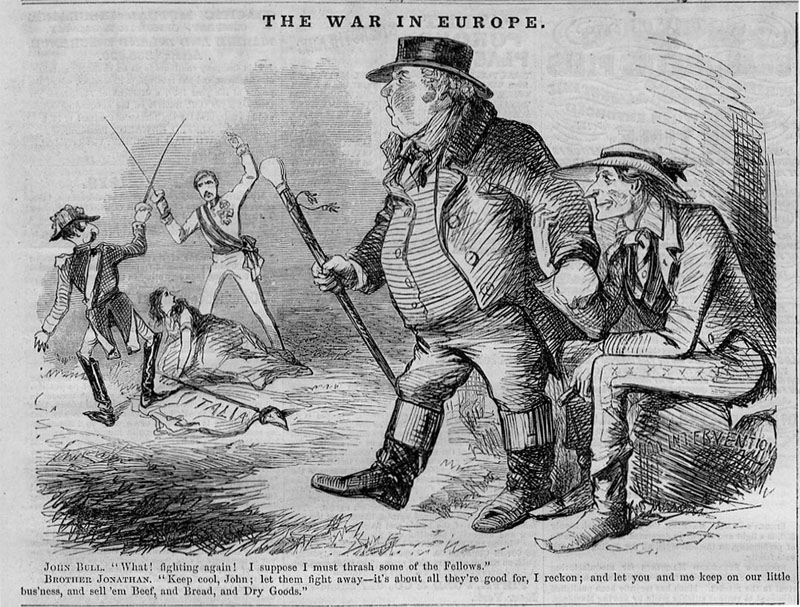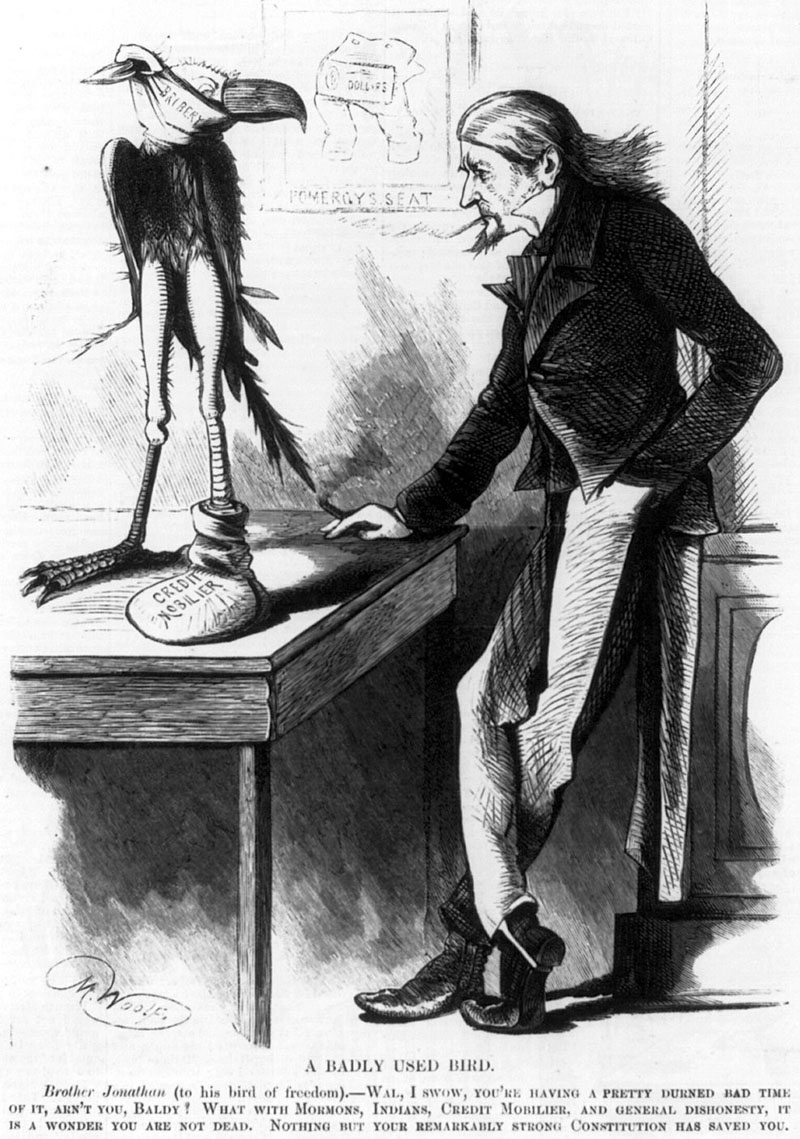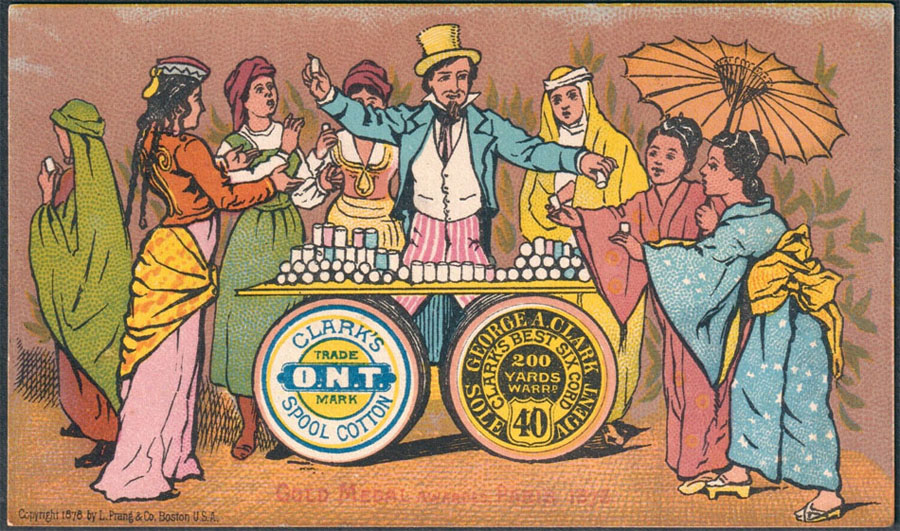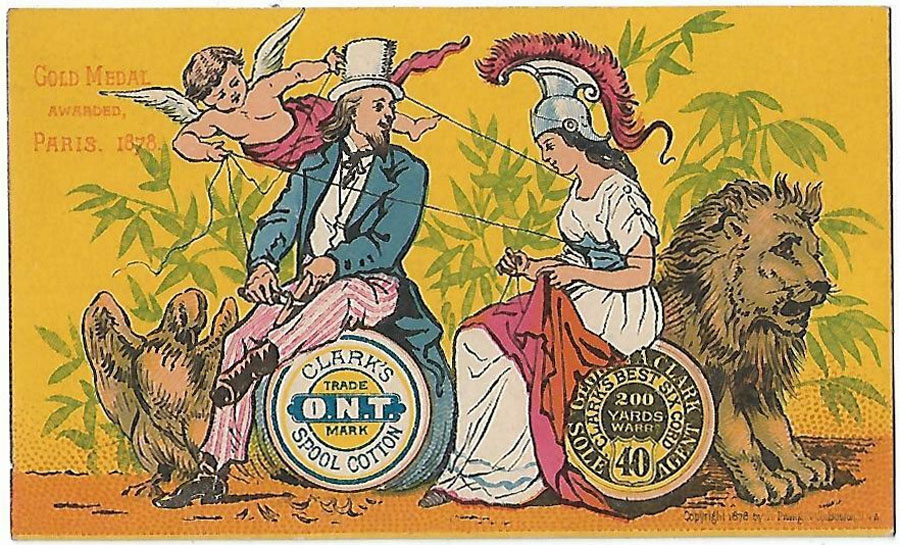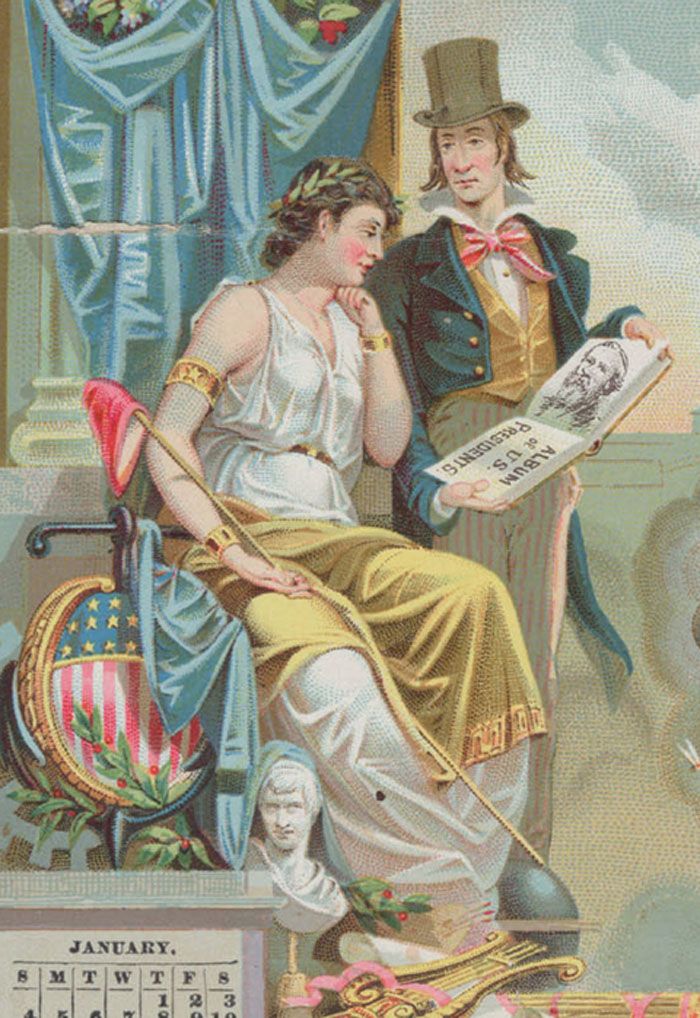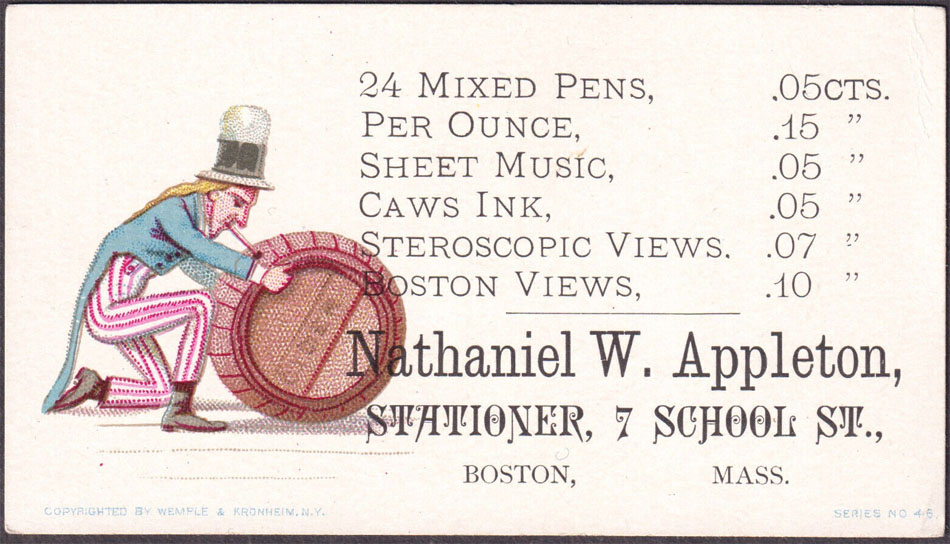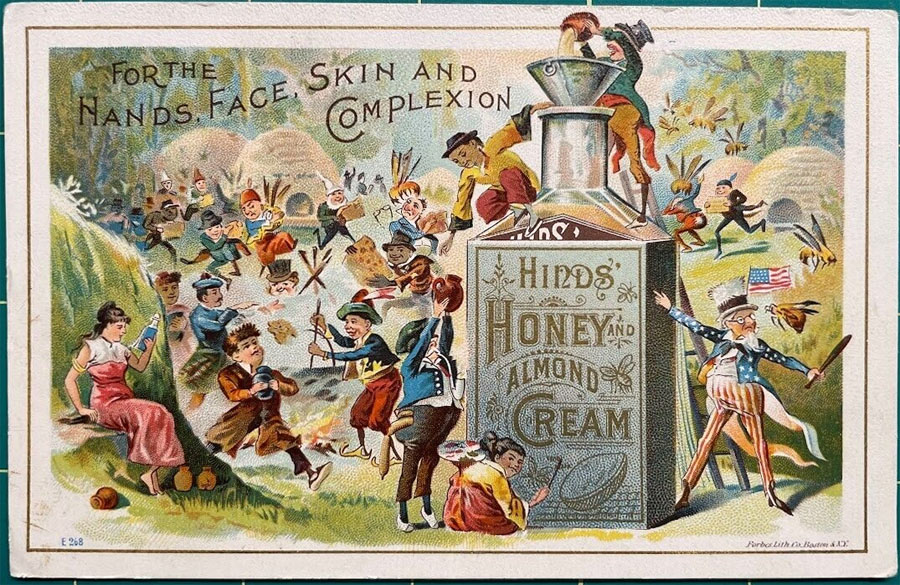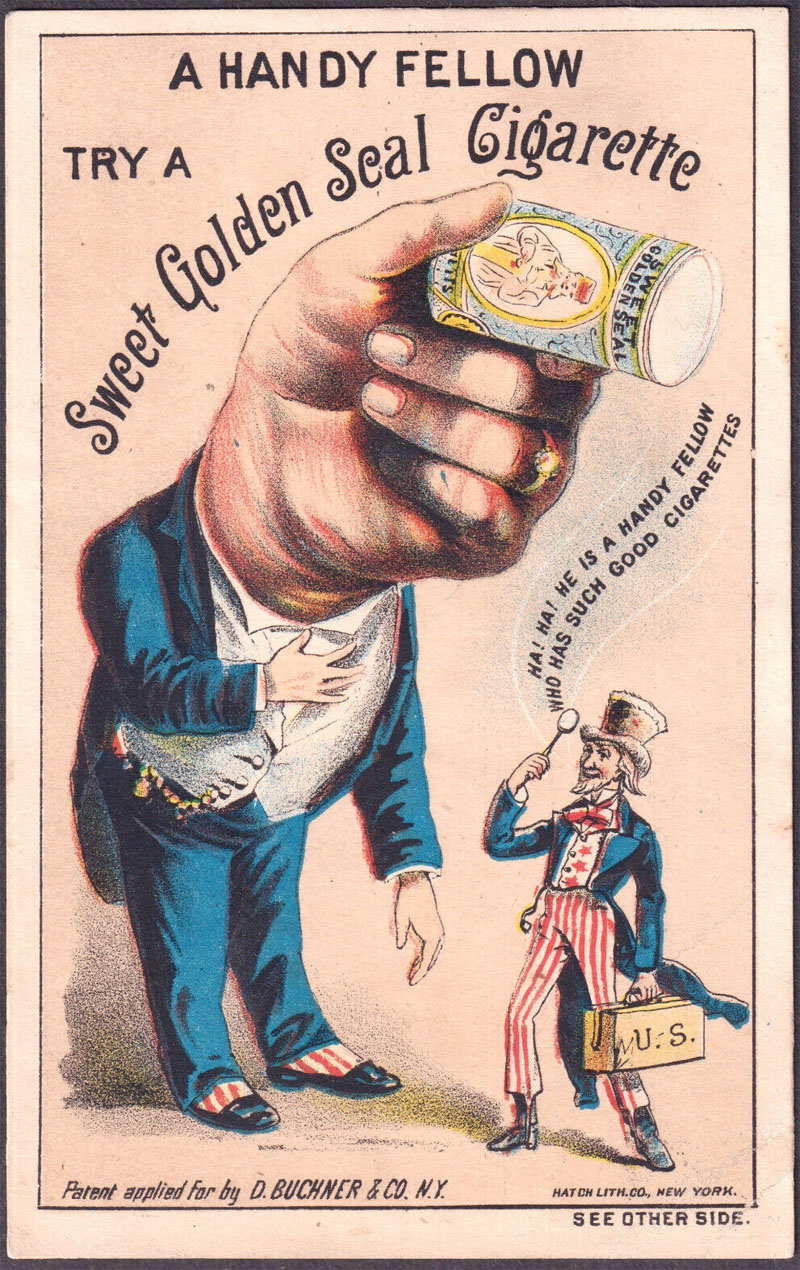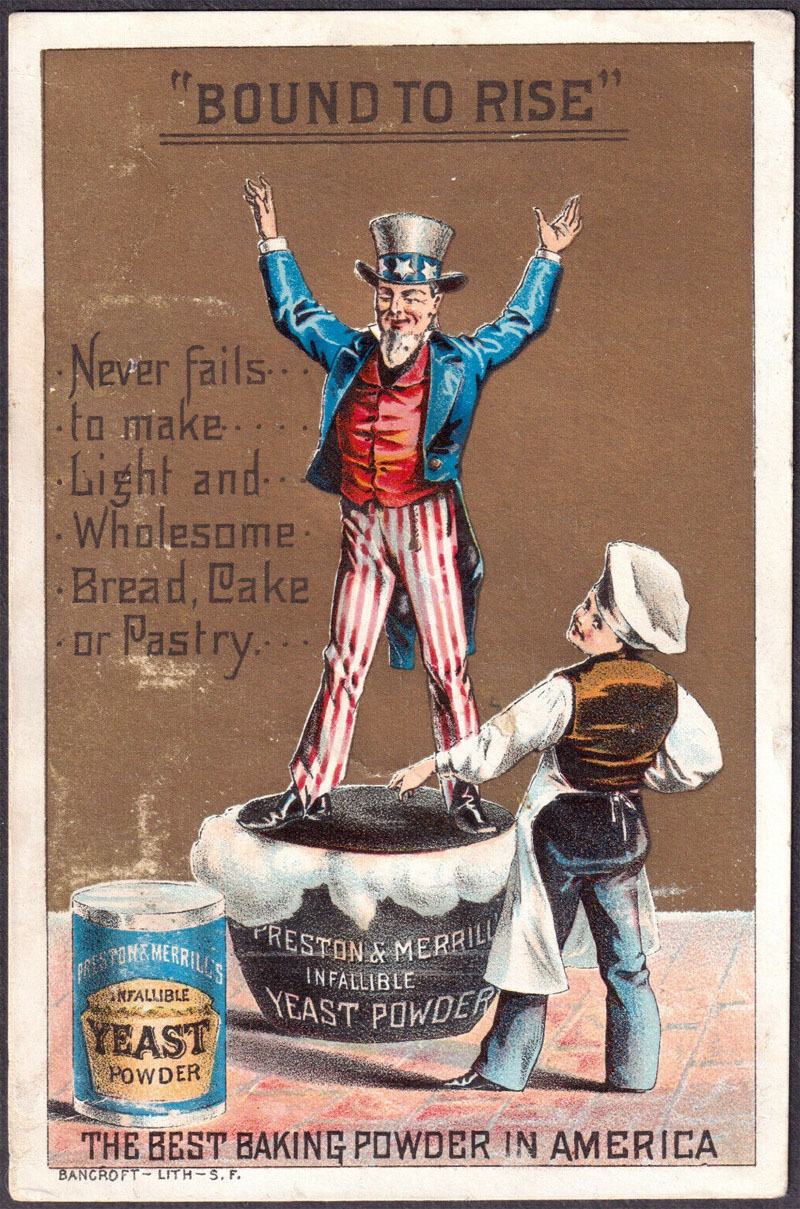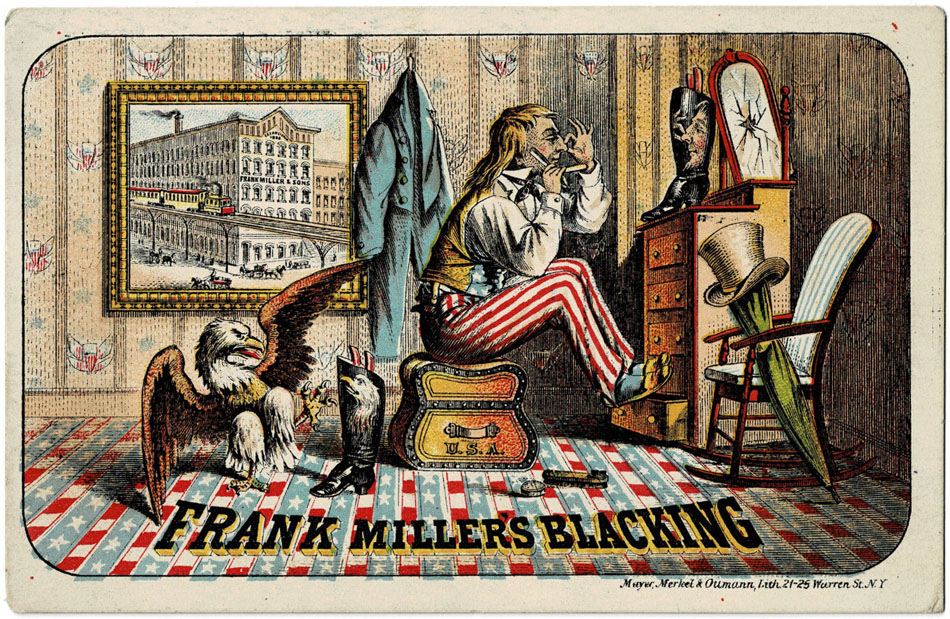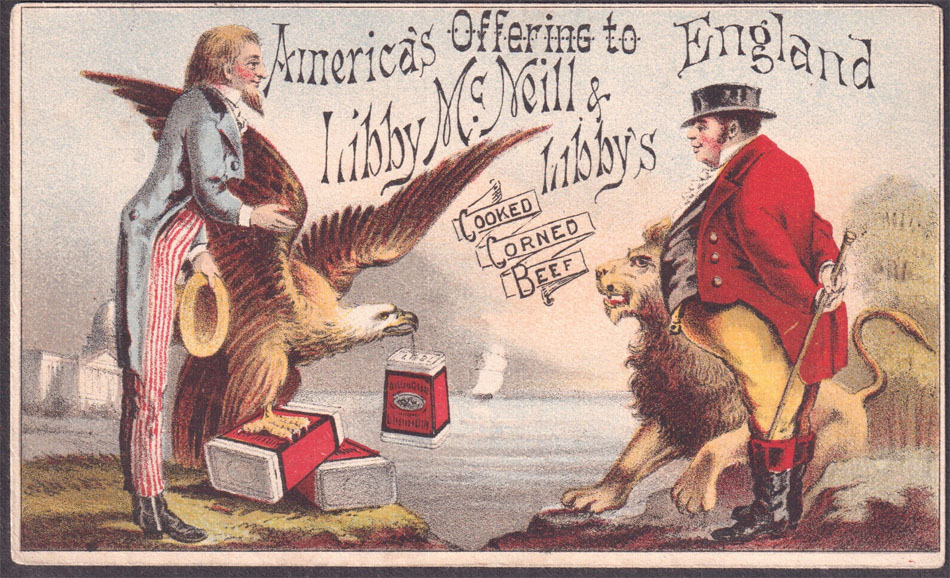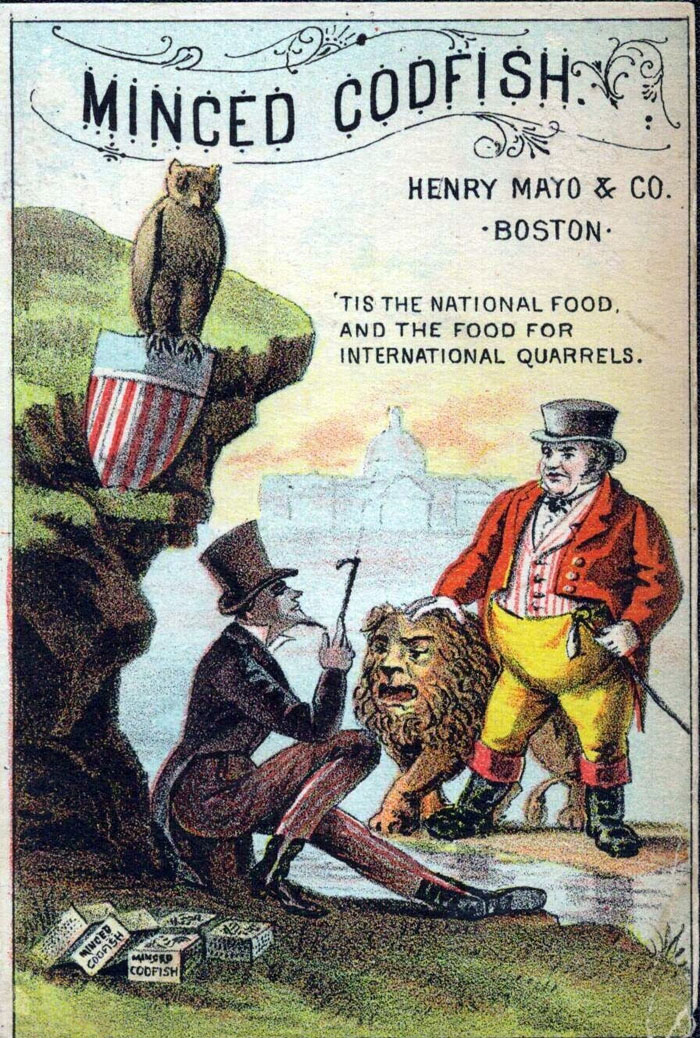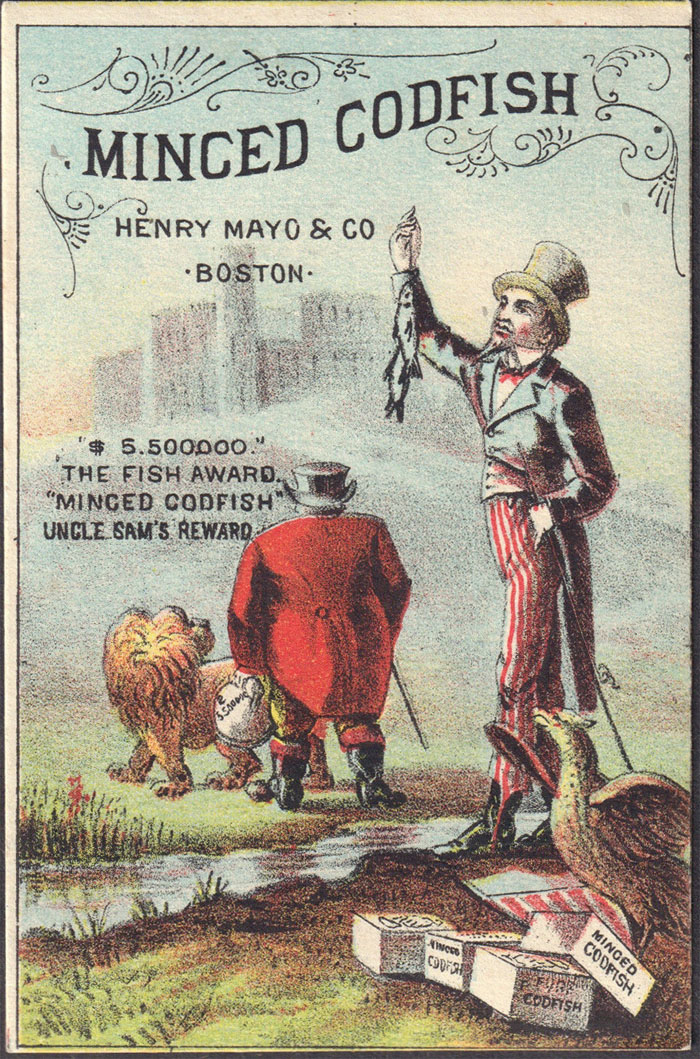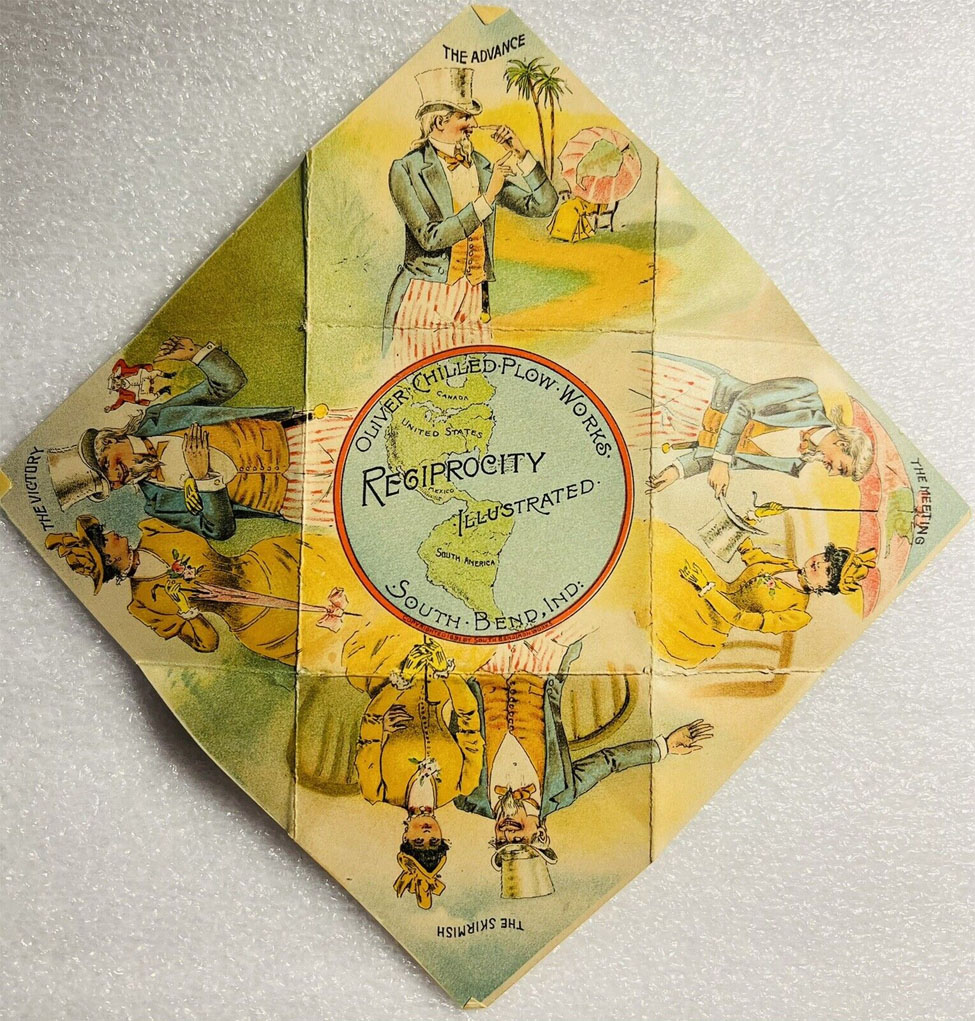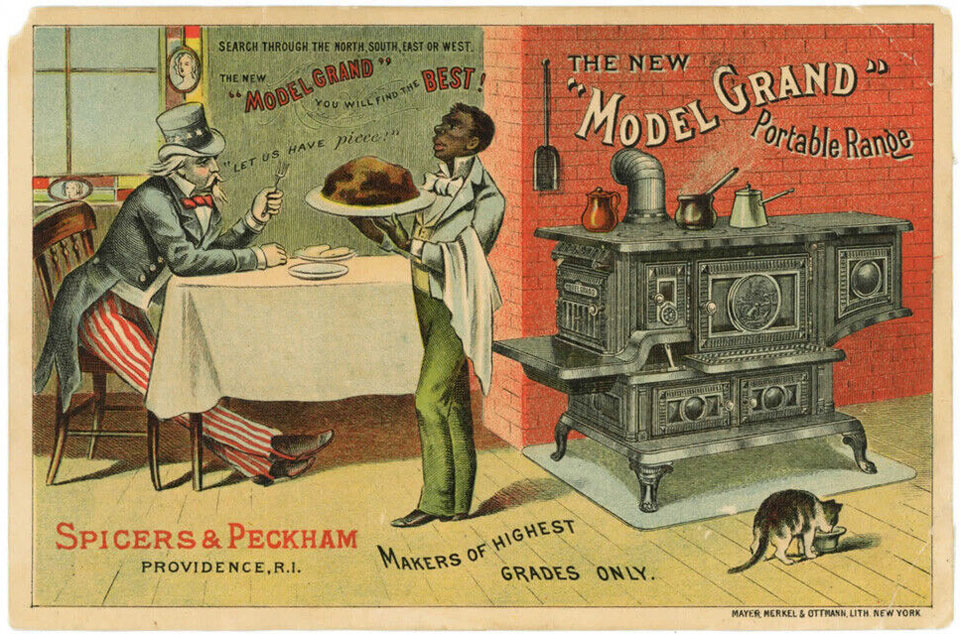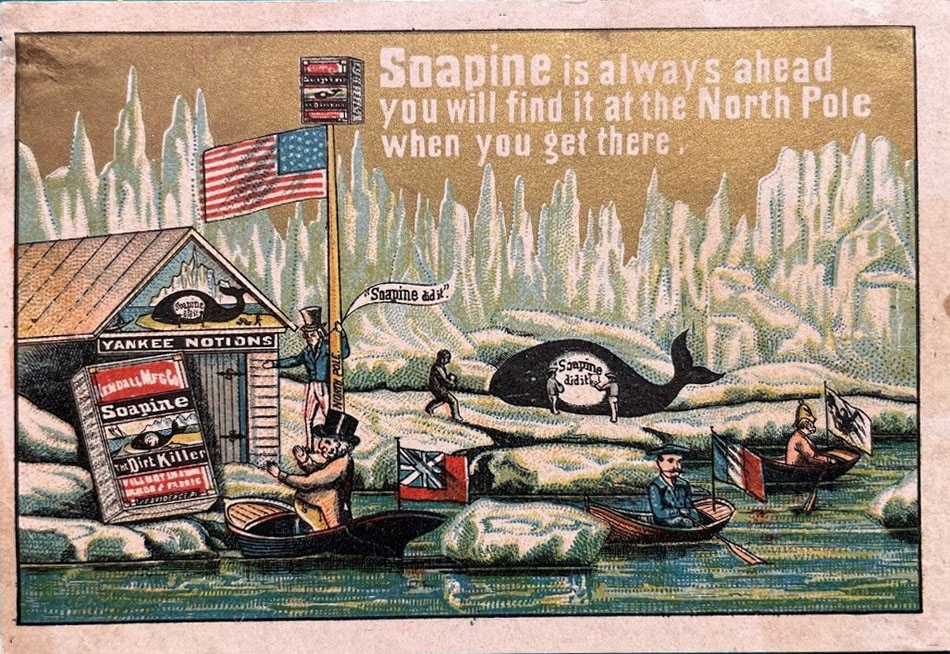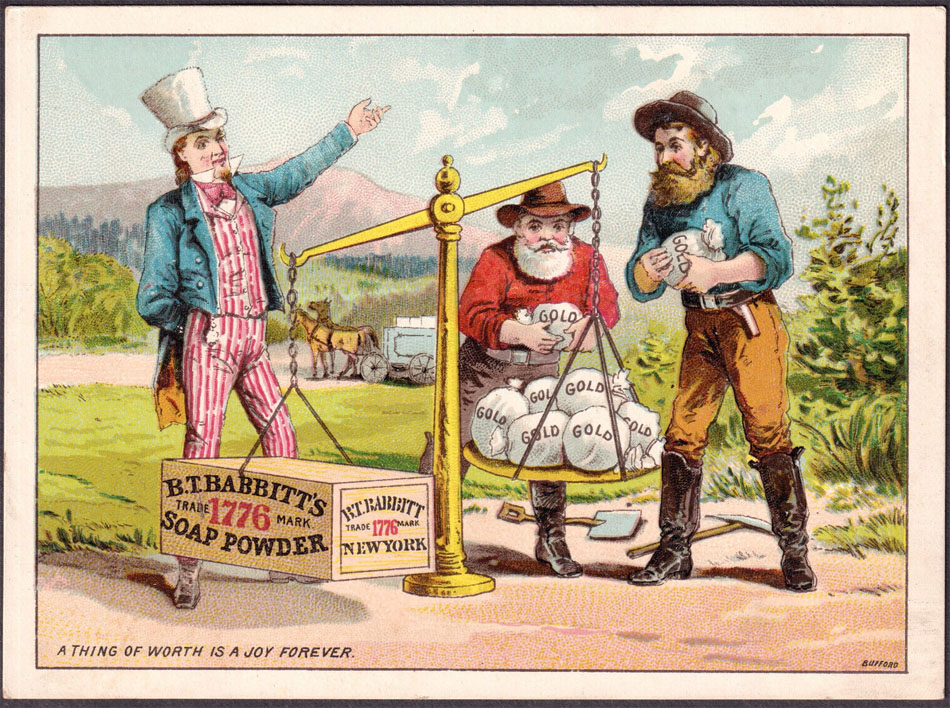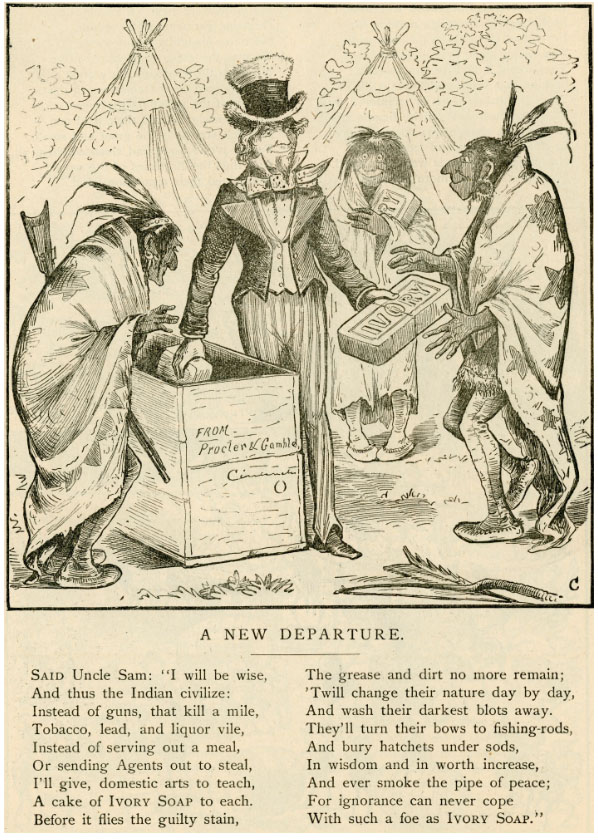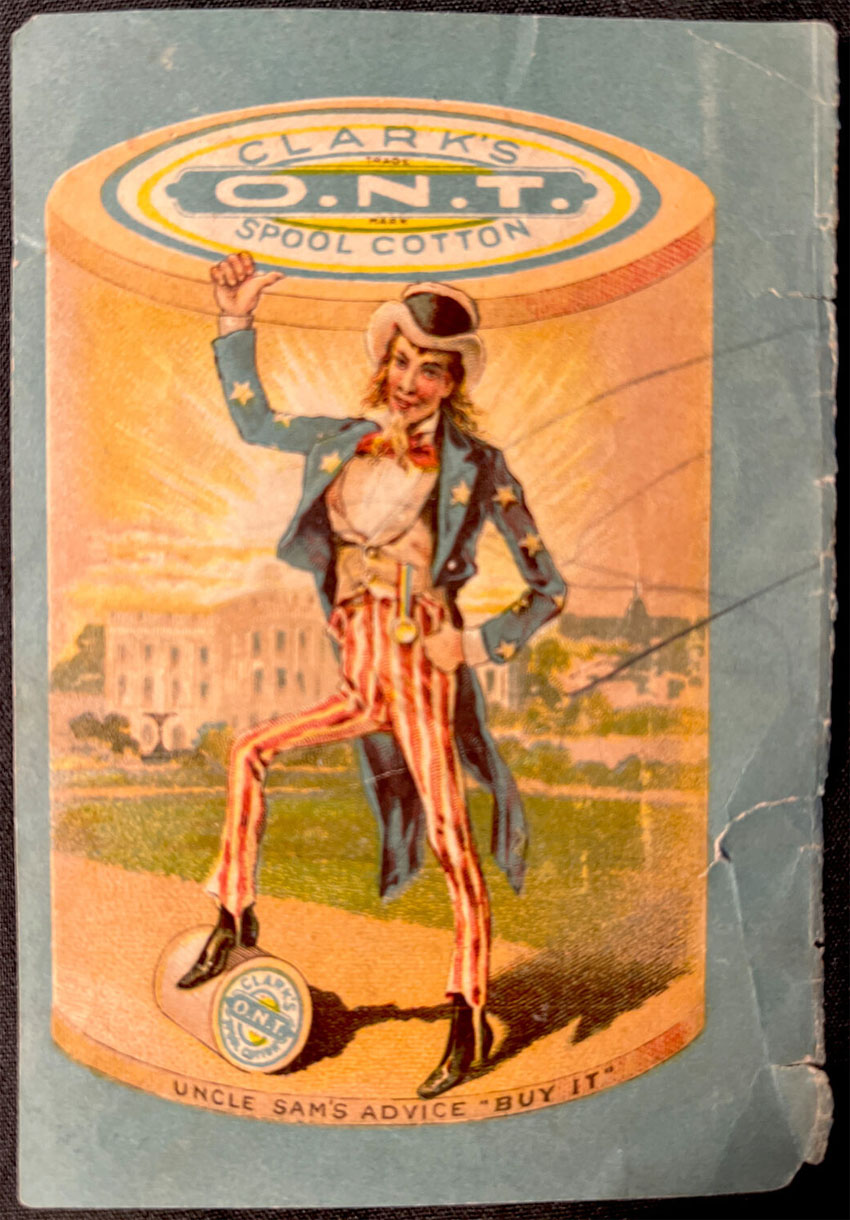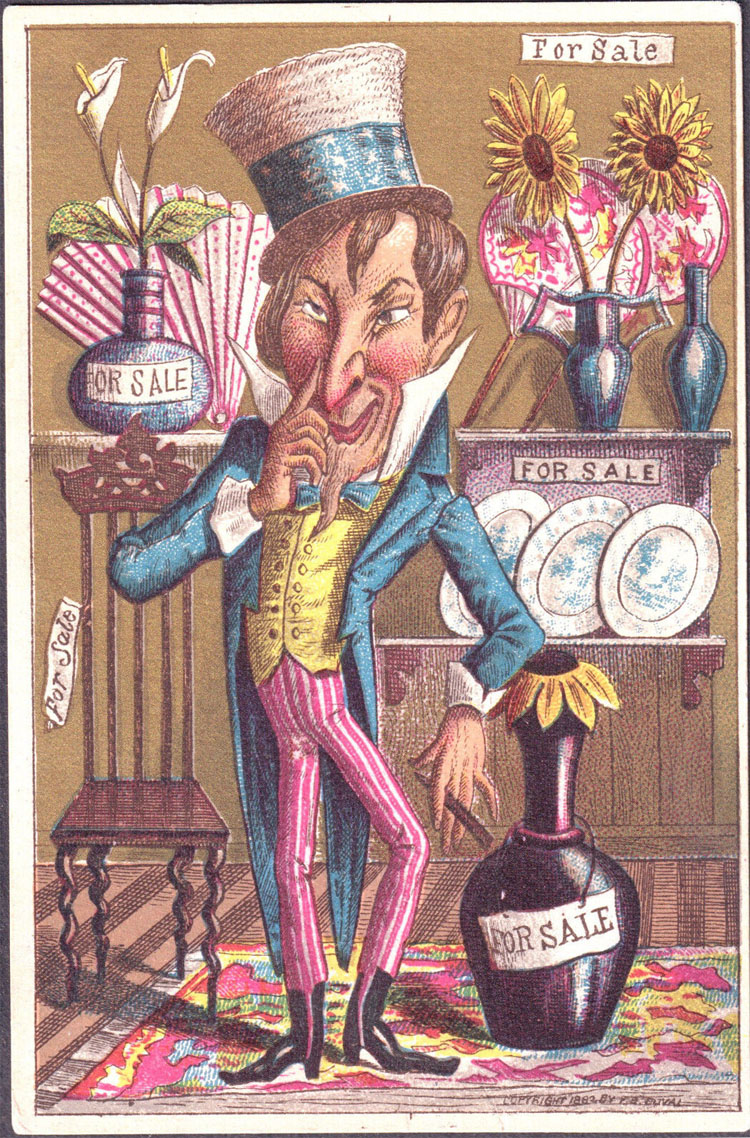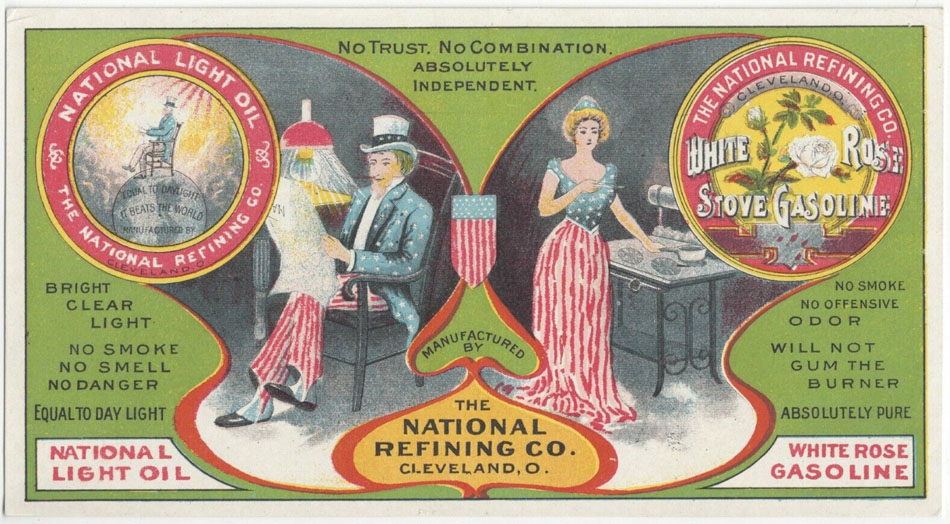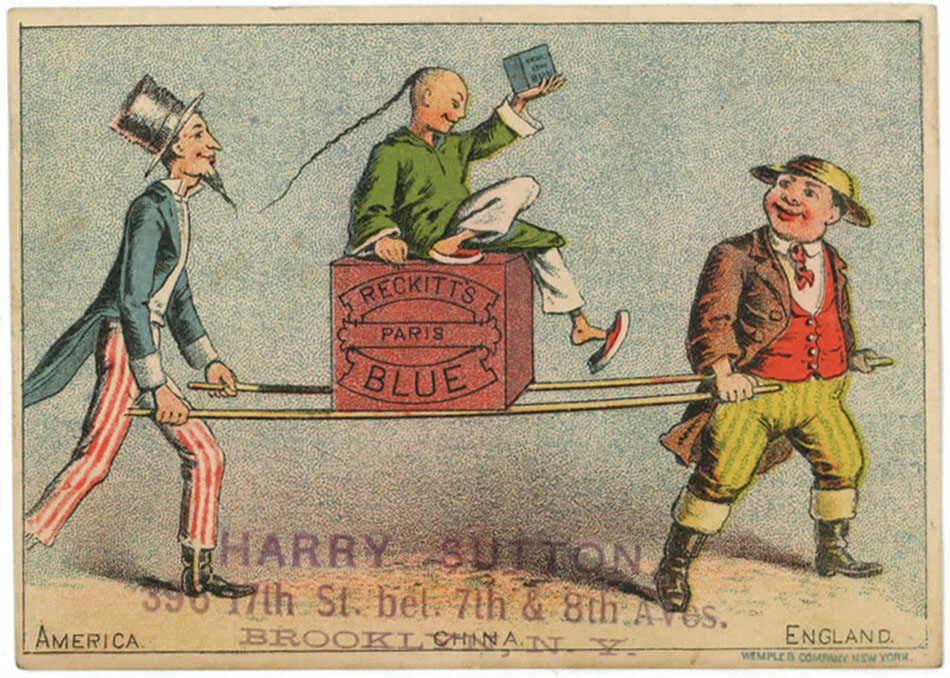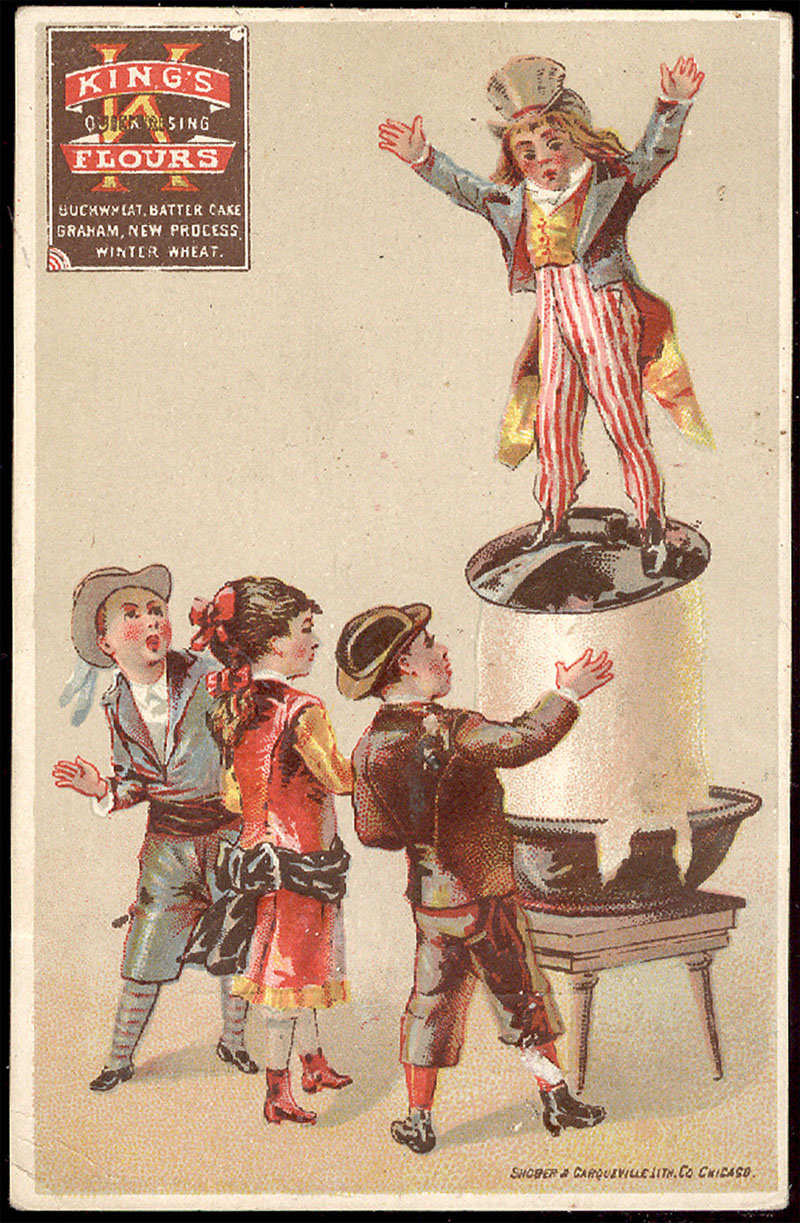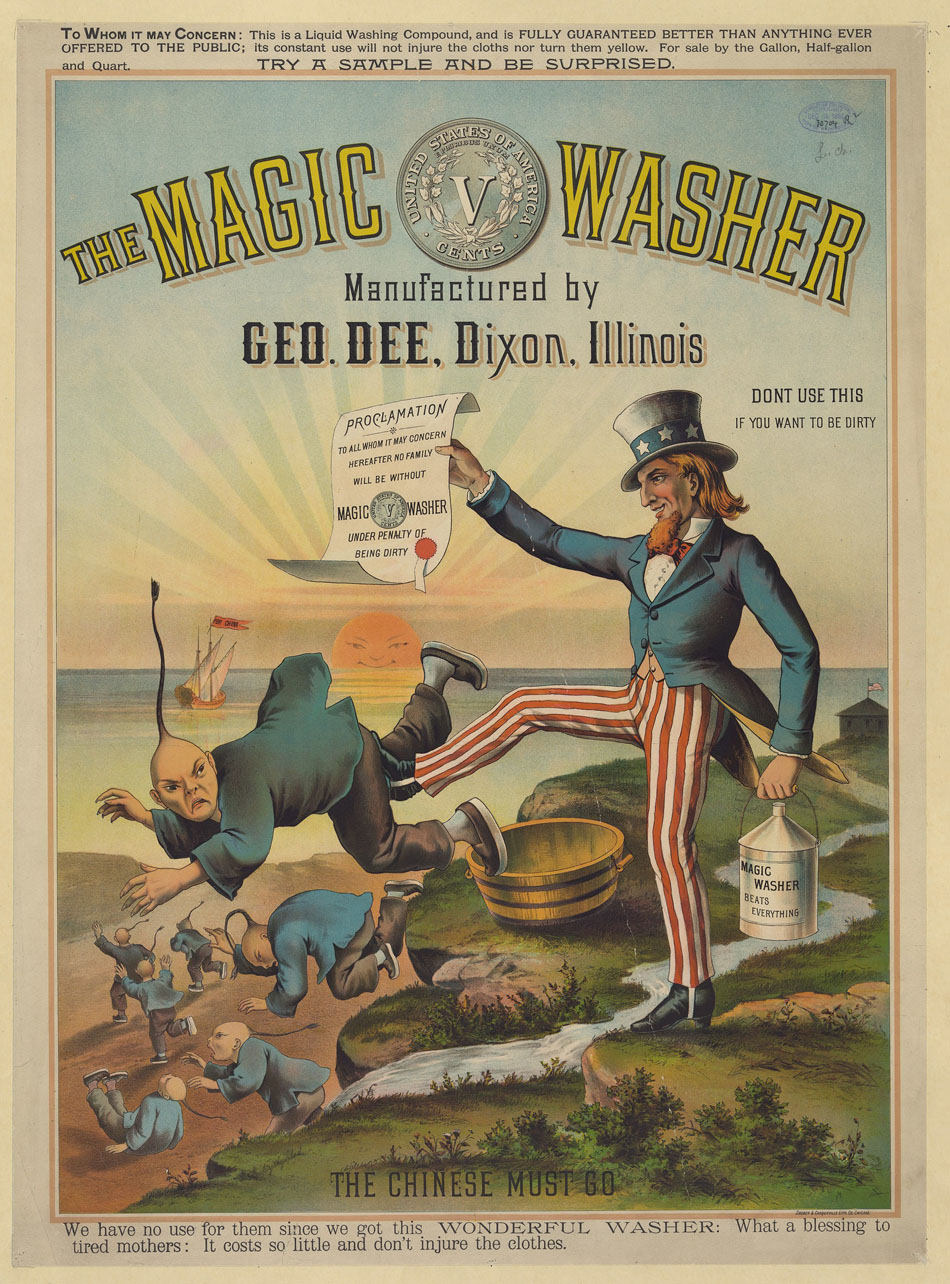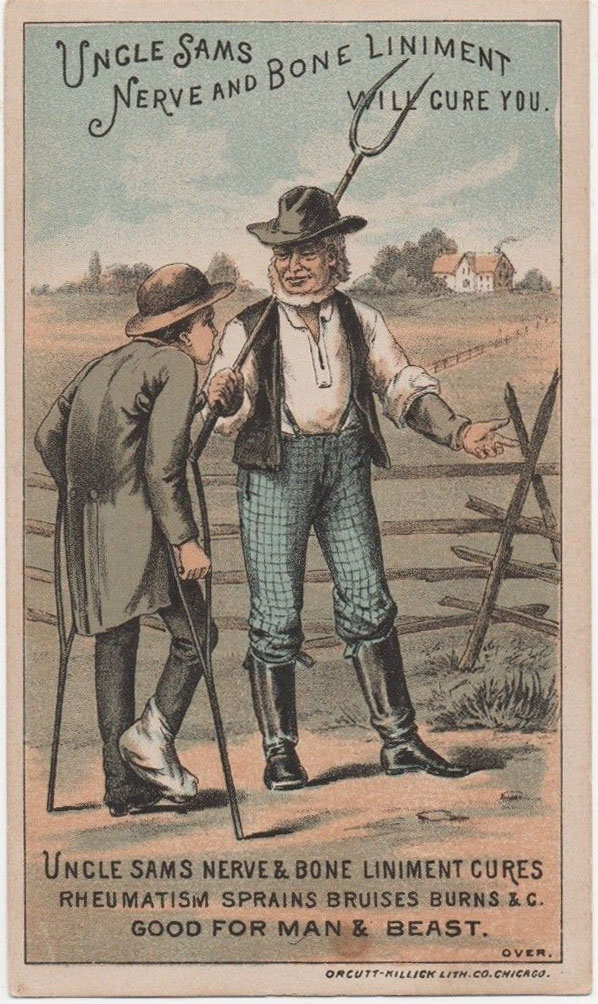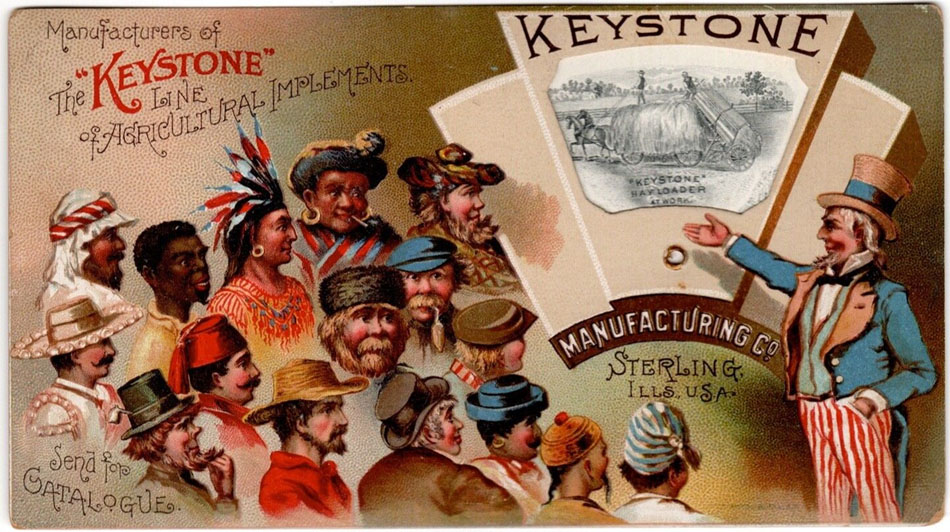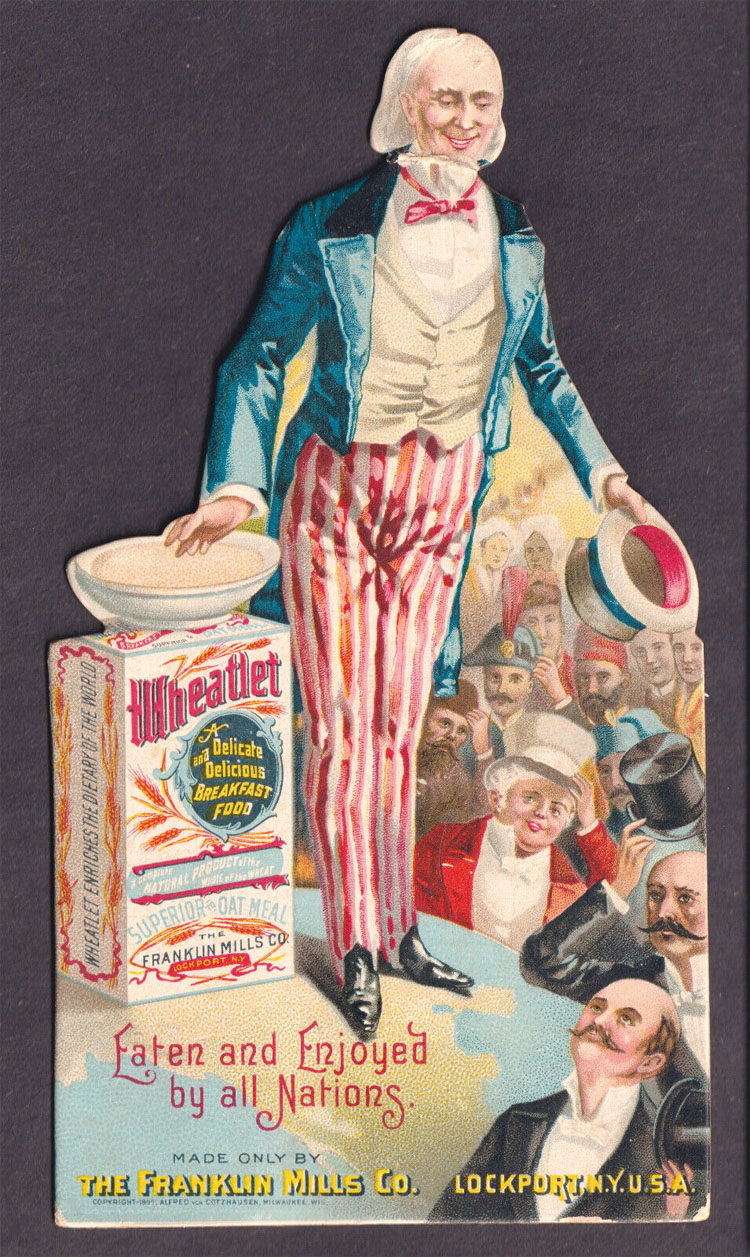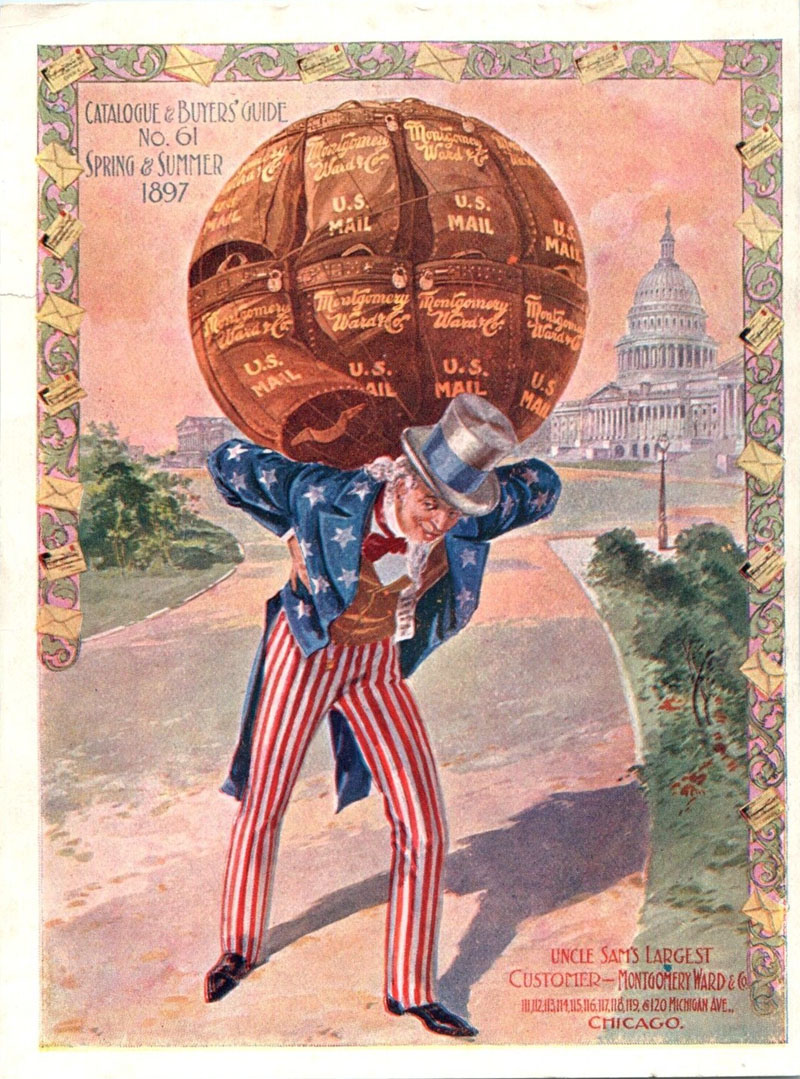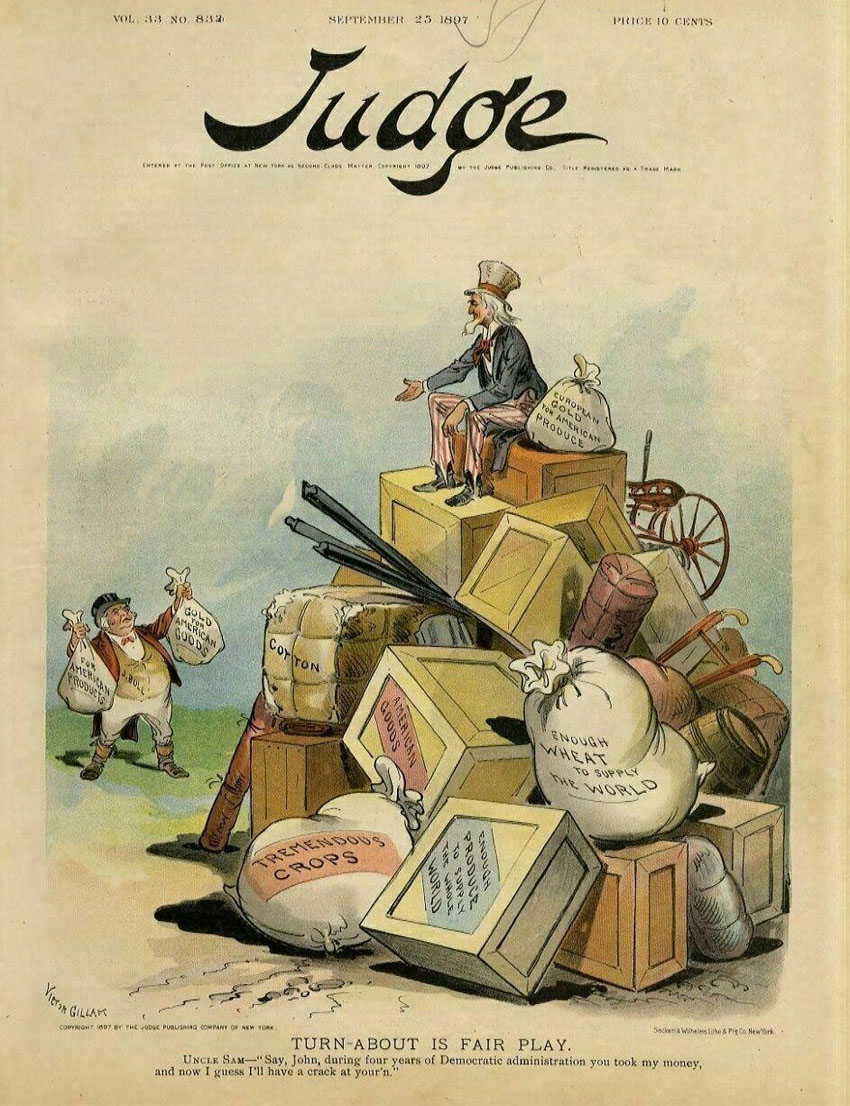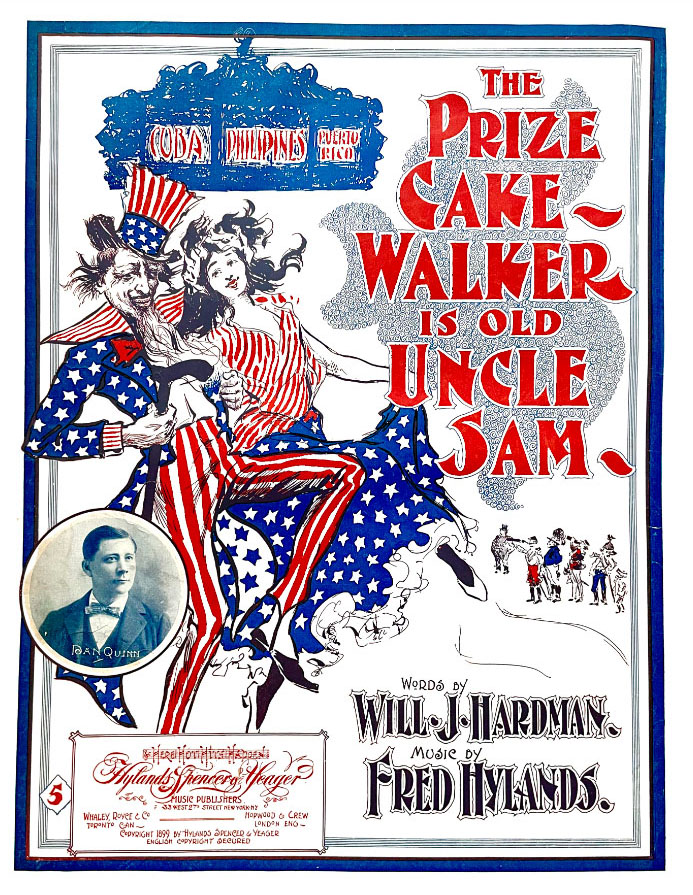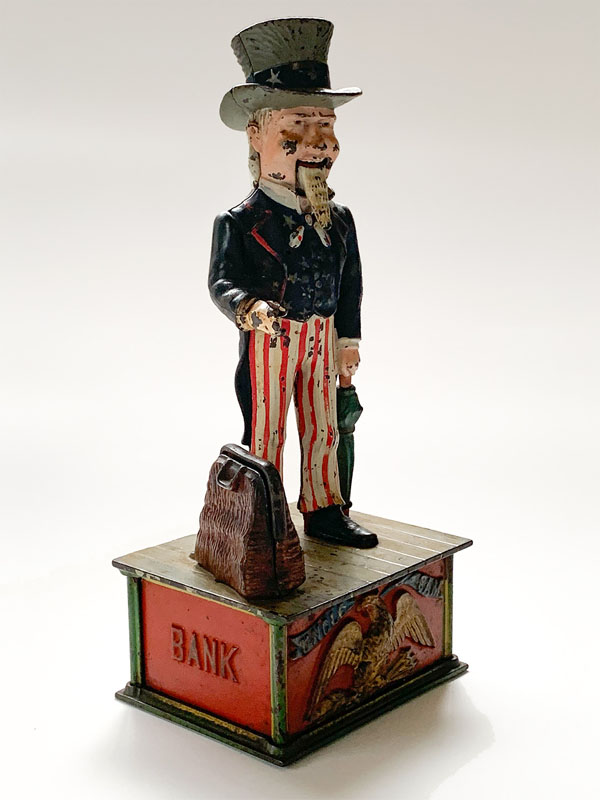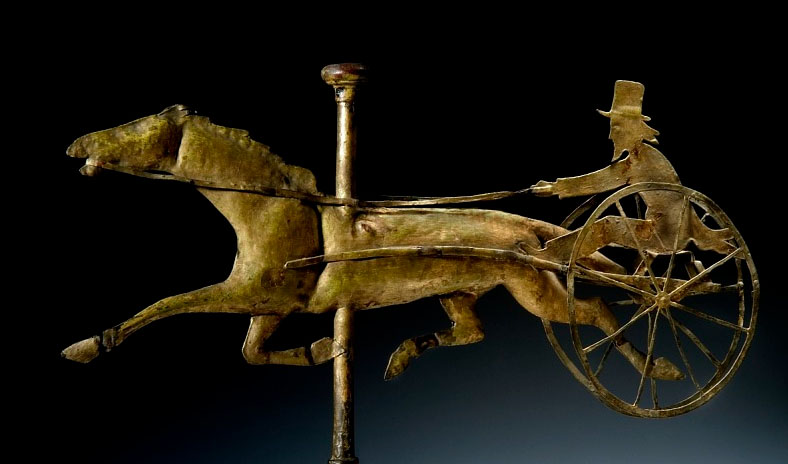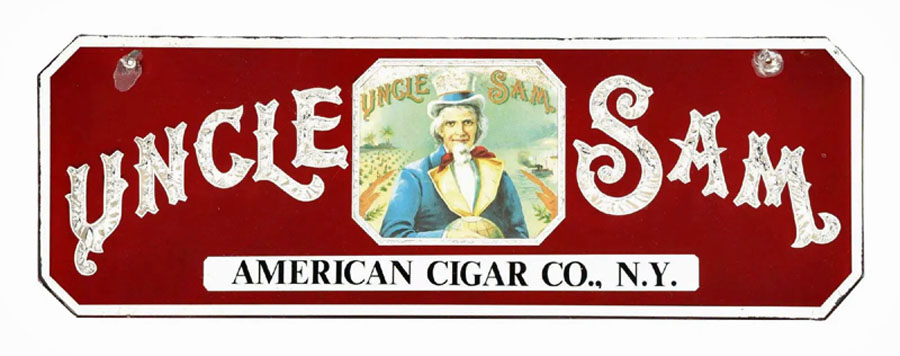|
Uncle Sam and Brother
Jonathan: Salesmen
1876 - 1900
Brother
Jonathan celebrates the American centenary at the 1876 Philadelphia
World's Fair
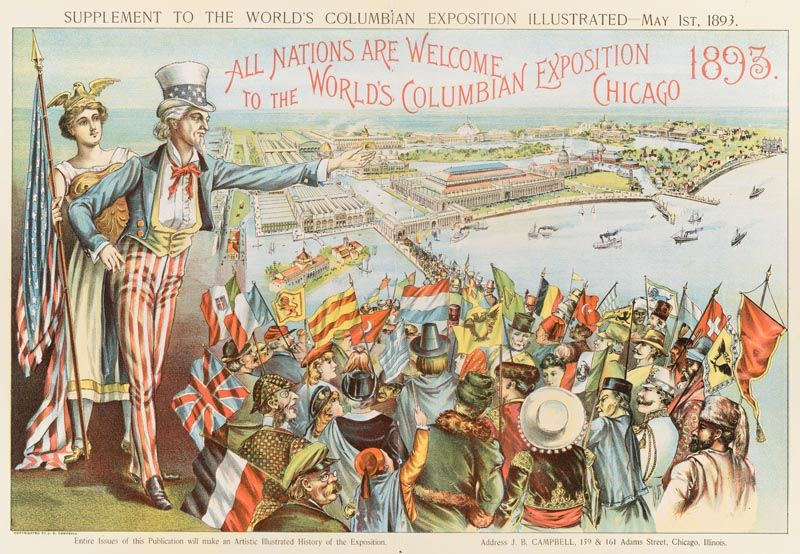
Uncle
Sam and Columbia Host the 1893 Chicago World's Fair
By Doug Boilesen 2023
Phonographia are connections with
the phonograph in popular culture.
On this page, however, there is only
one phonograph actually illustrated: An advertisement for Mrs. Potts'
Sad Irons in Frank Leslie's Illustrated Newspaper, June 1,
1878 features an Edison tinfoil Phonograph being played by an unidentified
operator. The operator, often
assumed to be Uncle Sam, was not advertising Edison's phonograph
-- he was promoting Mrs. Potts' Sad Irons and supporting the delivery
of Sad Irons to the Czar of Russia.
The other phonograph connection on
this page is an 1894 trade card of Uncle Sam promoting Hub Gore
shoes. The card states that "Uncle Sam, the Wonderful Edison
Talking Automaton" delivered 40,000 speeches during the 1893
World's Columbian Exhibition which means an Edison Phonograph was
used for the talking, but no Phonograph is pictured.
Frank Leslie's
Illustrated Newspaper advertisement for Mrs. Potts' Sad Irons,
June 1, 1878.
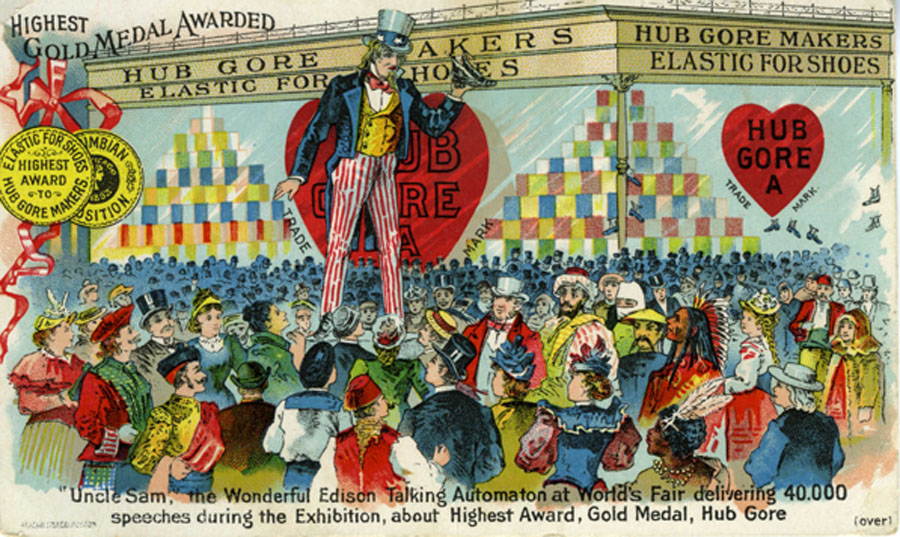
Uncle Sam promoting Hub Gore
shoes with the automaton using an Edison Phonograph to "talk."
(Beacon Lith Co., Boston,
March,1894) (PM-0650)
The Mrs. Potts' Sad Iron ad of June
1, 1878 is the focus of this page because it's the first advertisement
in popular culture to illustrate the Edison tinfoil Phonograph while
not advertising the Phonograph, and it raises the question: "Who
is the operator of that Phonograph?"
Is
it Brother Jonathan or Uncle Sam?
Brother Jonathan had an earlier history
than Uncle Sam. References show that the "Brother Jonathan"
nickname was mockingly used by the British before and after the
Revolutionary War. "Brother Jonathan" was also a general
designee for early colonists in New England and "Yankees."
Uncle Sam is first referenced later
(circa 1810). Brother Jonathan and Uncle Sam would be in print and
illustrated until after America's civil war when morphing
took place to ultimately redefine Uncle Sam as the primary symbol
of the re-unified United States.
It's within that morphing context
that the Mrs. Potts' ad is examined and a "probable"
suggestion is made about the identification of the figure operating
the Edison Tinfoil Phonograph.
The last section of this
page, "The Gallery of Endorsements made by Brother Jonathan
and Uncle Sam: 1876 - 1900," displays various consumer
products which were promoted by Brother Jonathan and Uncle Sam beginning
in 1876, when Brother Jonathan
had a prominent role at the 1876 Philadelphia World's Fair, and
ending in 1900, when Brother Jonathan had largely disappeared from
popular culture and all of his roles had been transferred to Uncle
Sam.
Table
of Contents
Brother
Jonathan
Uncle
Sam
The
Morphing of Brother Jonathan and Uncle Sam
Brother
Jonathan and Uncle Sam promoting Mrs. Potts' Sad Irons
- Four Mrs. Potts' Sad Iron ads and other Uncle Sam and Brother
Jonathan illustrations help to suggest the most likely identity
of the phonograph operator in Mrs. Potts' Sad Irons ad of June 1,
1878.
Uncle
Sam and Brother Jonathan: Salesmen 1876 - 1900
The
Gallery of Endorsements made by Brother Jonathan and Uncle Sam:
1876 - 1900 - Trade cards and advertisements showing Uncle
Sam and Brother Jonathan promoting American products from 1876-1900.
Additional
Examples and Postscript
Brother Jonathan
An article in the Tulare County
Times, January 5, 1878 explained that the history
of Brother Jonathan was based on George's Washington's
reliance on Connecticut Governor John Trumbull during the Revolutionary
War. The by-phrase "We must consult Brother Jonathan"
resulted in Brother Jonathan becoming "a designation
for the whole country, as John Bull has for England."
The provenance of the term Brother
Jonathan is mixed and the Trumbull story seems to be a questionable
addendum/folktale to his earlier history. There is some early association
between Brother Jonathan and Yankee Doodle and since neither were
illustrated at the time there is the song and the reputation but
no specific depictions.
The song was a pre-Revolutionary
War song originally sung by British military officers to mock
the disheveled, disorganized colonial "Yankees" with whom they
served in the French and Indian War...The British troops sang
it to make fun of their stereotype of the American soldier as
a Yankee simpleton who thought that he was stylish if he simply
stuck a feather in his cap. It was also popular among the Americans
as a song of defiance, and they added verses to it that mocked
the British and hailed George Washington as the Commander of the
Continental army. By 1781, "Yankee Doodle" had turned from being
an insult to being a song of national pride. - Wikipedia
extracted 10-01-2023)
What does seem consistent is that
the earliest addressing of someone as “Brother Jonathan” by the
British was based on a stereotyped view of the character of New
Englander colonists and of those they called "Yankees."
After the Revolutionary War Brother
Jonathan would be referenced in newspapers, and in 1813 he was illustrated
in a broadside as an early American foil to John Bull -- a depiction
which showed Brother Jonathan's boldness in his
"Administering a Salutary Cordial to John Bull."
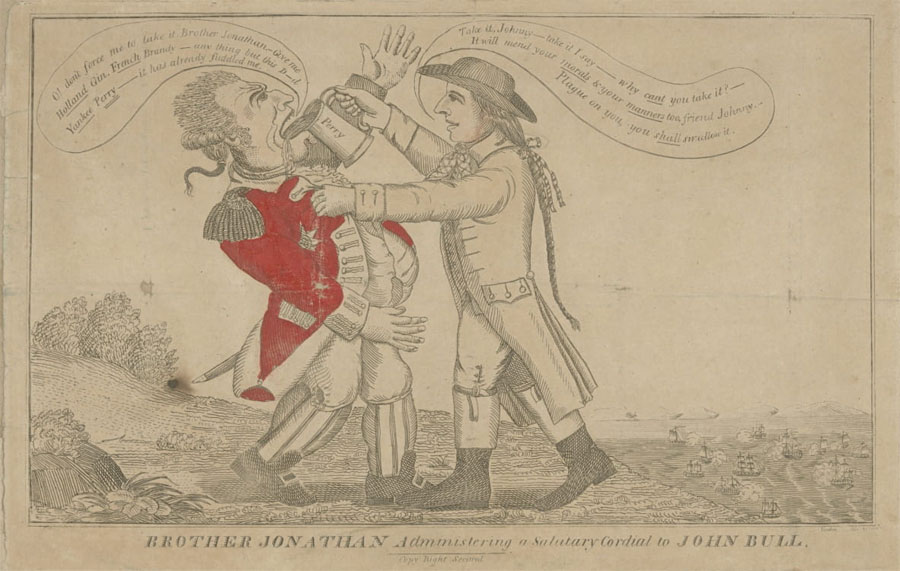
Brother Jonathan and John Bull by
Amos Doolittle, 1813 (Print available for purchase from MEISTERDRUCKE.)
John Bull and Brother Jonathan
would be seen paired in broadsides and newspaper cartoons before
1862 (like the above example) when Uncle Sam started taking
over more of that relationship with John Bull.
Another broadside from 1813 shows
"John Bull" personifying King George III fighting
and addressing a figure as Brother Jonathan (who the
Library of Congress identifies as James Madison). Brother Jonathan
responds to John Bull by saying "I'll let you know we are
an Enterprizeing Nation, and ready to meet you
with equal force any day."
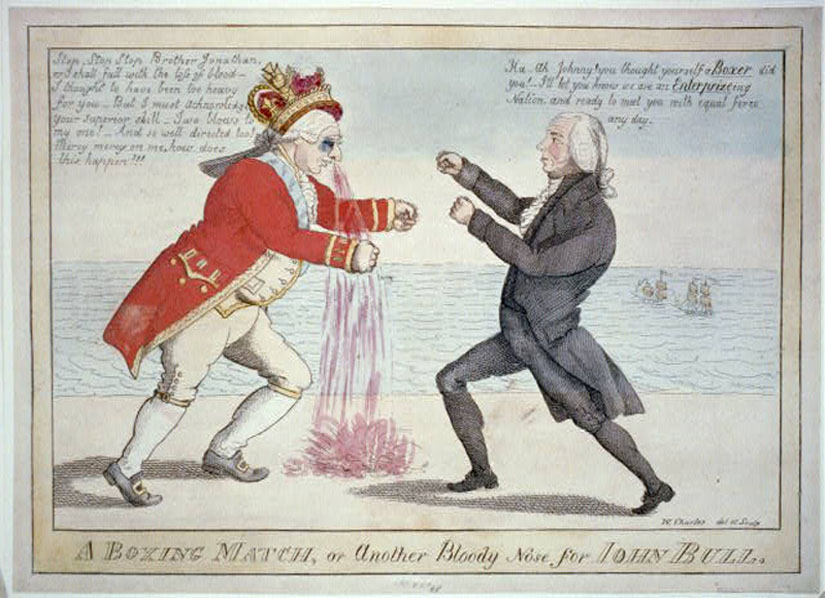
Brother Jonathan fighting
in "A boxing match, or another bloody nose for John
Bull," 1813 (Library
of Congress)
Uncle Sam and Brother Jonathan
would develop their own personas, roles and features with their
depictions dependent on their illustrators, the context of the
scene and the intent of the illustration. Brother Jonathan's
stove-pipe hat and striped pants would be adopted by Uncle Sam
and after the United States civil war further morphing would
create a redefined Uncle Sam.
By the end of the nineteenth century
Uncle Sam would be the symbol personifying the government of the
United States. Brother Jonathan essentially disappeared as his own
figure in popular culture but even in 1900
the term Brother Jonathan could still be a name used in popular
culture such as in the illustration of American troops and "Brother
Jonathan" fraternizing
with British soldiers in Gibralter circa 1900. That
use of "Brother Jonathan" as a name for anyone from the
United States also went back to Brother Jonathan's earliest designation
as an "everyman" of the country.
Pre-1878 Brother Jonathan Illustrations
and Examples
An 1837 illustration (below) may be
unique in showing Uncle Sam and Brother Jonathan in the same illustration.
A "sick" Uncle Sam
is sitting in a chair. Brother Jonathan is outside the window talking
to Nicholas Biddle and saying he is hopeful that "Dr. John
Bull" can provide some assistance.
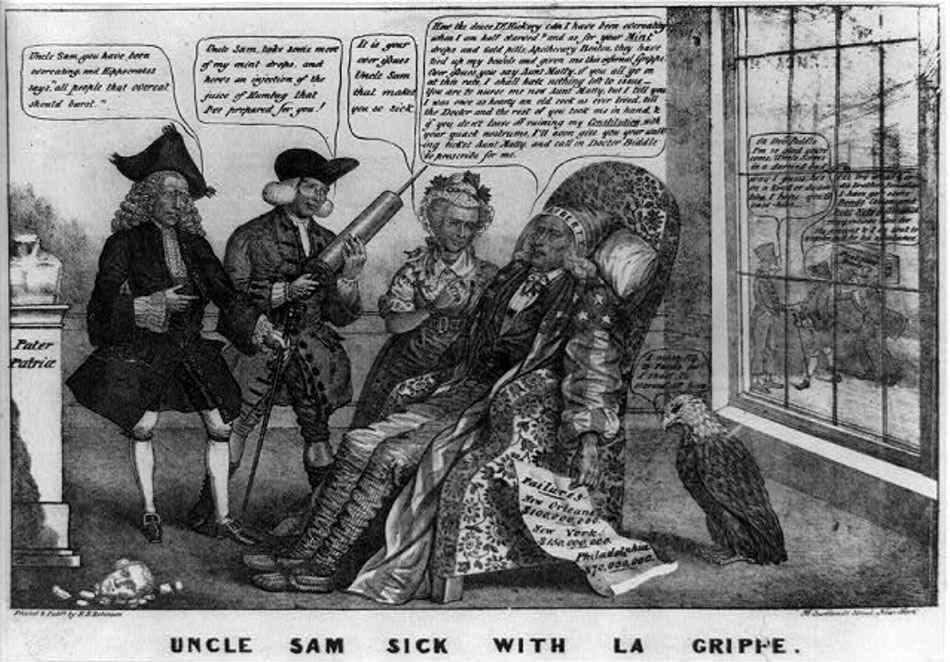
|
A satire attributing the
dire fiscal straits of the nation to Andrew Jackson's banking
policies...
In an eighteenth-century
sickroom scene Uncle Sam, wearing a liberty cap, a stars-and-stripes
dressing gown, and moccasins, slumps in a chair. In his
hand is a paper reading "Failures / New Orleans right Nicholas
Biddle arrives, with a trunk of "Post Notes" and "Bonds,"
and is greeted by Brother Jonathan.
Jonathan: "Oh Docr. Biddle
I'm so glad you're come. Uncle Sam's in a darned bad way
. . ."
Biddle: "I'll try what
I can do . . . & I've sent to Dr. John Bull for his assistance."
New York : Printed & published
by H.R. Robinson, 1837. (Description and illustration from
Library
of Congress)
|
|
As was seen in the previous 1813
example of Brother Jonathan fighting and announcing to John
Bull that "we are an enterprizeing Nation, and ready
to meet you with equal force any day," Brother Jonathan's
support of American markets and the goal of becoming a prosperous
nation would be one of his important roles as a symbolic representative
of America into the 1870's.
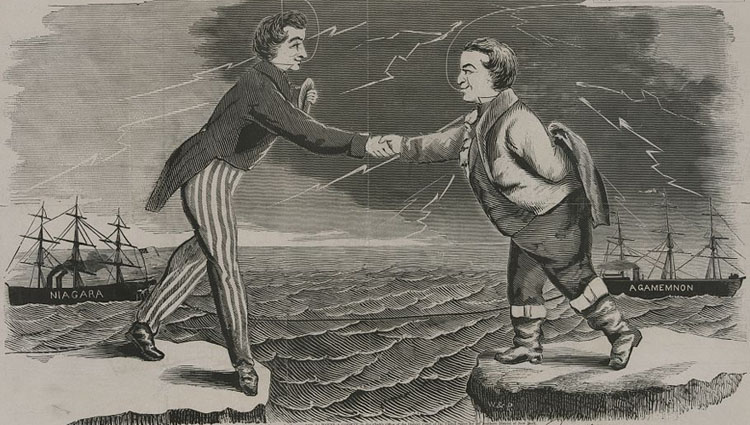
The TransAtlantic
Cable transmitted its first message on August 17, 1858. The
artist shows Brother Jonathan (left) shaking hands with
John Bull. (Library
of Congress).
In the Atlas Obscura
article by Adee Braun, July 4, 2019 (originally published
July 3, 2017) titled "Before
America Got Uncle Sam, It Had to Endure Brother Jonathan"
Braun wrote that Brother Jonathan was "brash, bold,
and bigoted, he made for an uneasy national mascot."
Brother Jonathan was a rustic
New Englander who was depicted at various times on stage as
a peddler, a seaman, and a trader, but always as a sly and cunning
figure. He began to show up in political cartoons in newspapers
and magazines during the early part of the 19th century as new
and cheaper printing methods developed. It was at this point
that American cartoonists transformed Brother Jonathan from
a figure of derision into one of patriotic pride. (Ibid.)
Brother Jonathan (left)
and John Bull titled "John Bull's Monarchy a Refuge from
Brother Jonathan's Slavery" (extract of wood-cut from American
Anti-Slavery Almanac, New York 1839) - (Courtesy Library
Company of Philadelphia)
"The War in Europe." John
Bull and Brother Jonathan, Harper's Weekly, June 1859 (an
example of Brother Jonathan's less attractive character who would
probably have agreed with banker/financier Nathan Rothchild that
"the time to buy is when there's blood in the streets.")
For more examples of the "brash
and bigoted" side of Brother Jonathan see "Sympathy
for Italian Organ Grinders," Harper's Weekly,
June 1859. Also, see another
example of Brother Jonathan's relationship with John Bull in "Jonathan
on the Mason and Slidell Affair," Harper's Weekly,
January 1862.
Description: Jefferson Davis confronts
Brother Jonathan, who stumbles under the enormous burden of
debt. Davis presents his willingness to rejoin the Union
if Brother Jonathan agrees to his regressive terms. Jonathan:
"Anything my 'erring brother' for the sake of getting our party
once more into power; although with this burden to carry the path
of peace 'will be a hard road to travel." (Source: Library of
Congress)
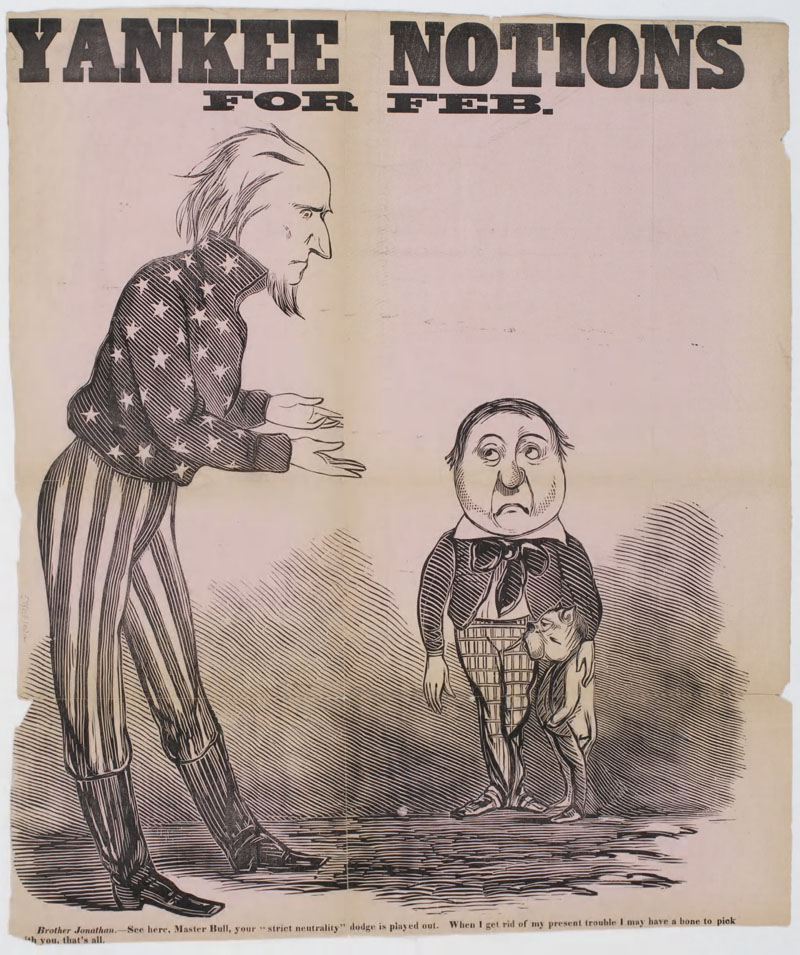
Brother Jonathan and John Bull,
Yankee Notions, February, between 1862 - 1865. (Source:
Library Company of Philadelphia)
Description: The illustration
shows a Yankee character addressing a British one, with the caption:
Brother Jonathan.--See here, Master
Bull, your "strict neutrality" dodge is played out. When I get rid
of my present trouble I may have a bone to pick with you, that's
all. (Ibid.)
Brother Jonathan and John Bull
Sheet Music
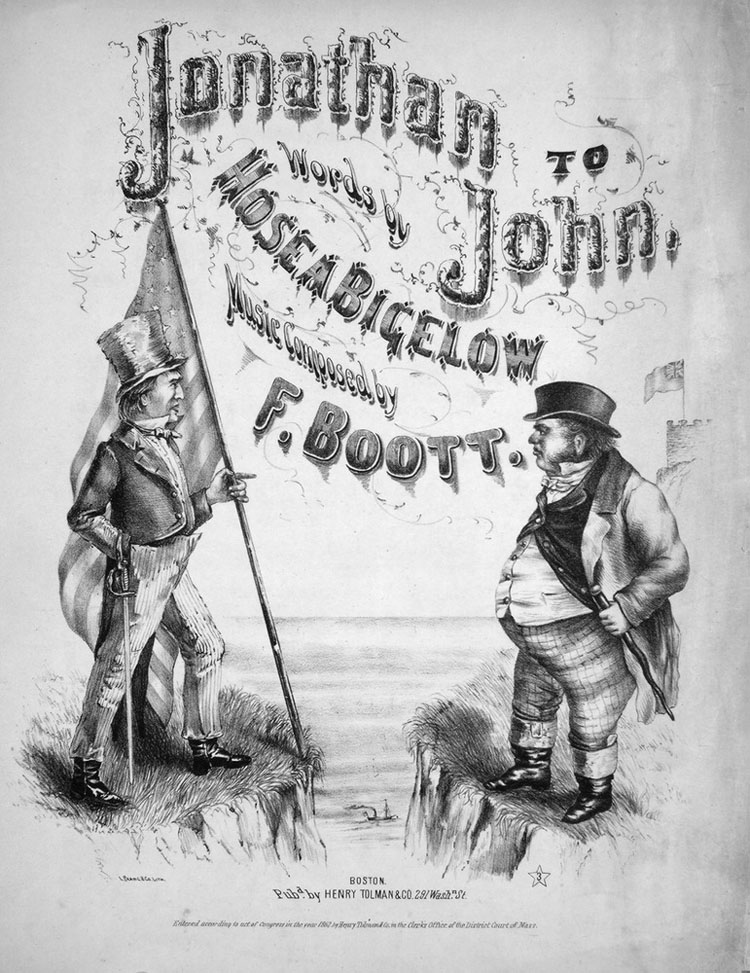
"Jonathan
to John." Words by Hosea Bigelow, Music by F. Boott.
Henry Tolman & Co., Boston, 1862. (Source: Lester S. Levy
Sheet Music Collection, Johns Hopkins.)
In 1877 a positive perspective about
Brother Jonathan (noted as being a factor "in the markets"
and "pushing his wares") was observed when The New
York Times (October
19, 1877, p.5) wrote that
Even in the old days, before
English people had begun to properly understand the American
character, they always gave Brother Jonathan credit for his
smartness, his humor, and his downright native wit. Brother
Jonathan is a factor in the markets of England in competition
with John Bull himself, pushing his wares in the very stress
of the old county. American pianos and American watches are
not only finding a large sale in England, but what is more,
they are beginning to be accepted for their excellence..."
A syndicated newspaper article reprinted
by The Wynadott Herald, September 26, 1878 titled
American
Nicknames noted that "A native American can not receive
a higher compliment than to be styled Brother Jonathan;"
This article then explained the origin of Brother Jonathan's name.
The Wisconsin State Journal
(June 26, 1878, p. 1) complimented Brother Jonathan's abilities
in international commerce, noting "he
will always keep his end level, in international commerce."
A a letter from the "CITIZENS
OF THE UNITED STATES TO BROTHER JONATHAN, OR RATHER THE GOVERNMENT"
was published in a newspaper along with a response from Brother
Jonathan. The letter expressed the unhappiness of the public
following the elections in 1874 where they had been promised
"better times" if they elected the Democrats.
This 1877 letter shows that Brother
Jonathan was someone the people felt they could ask for help and
be their spokesman to the United States Government.
Brother Jonathan's response to their
letter is revealing for his empathy (and calling them "My
children") and for his response (not saying that he was going
to do anything for them as a representative of the US government,
but rather for them to take action on their own by using their
votes):
"My children, it saddens
my heart to witness the evidences of hard times, in the thousands
upon thousands of unemployed citizens; and what you have said
of promises made to the country, is true. Congress will meet
in June, and it may be well to remind the men who were playing
fast and loose on the stump, of their broken promises. If
they can not help us, as they planned, they are only time-servers,
and should be remembered for their deception."
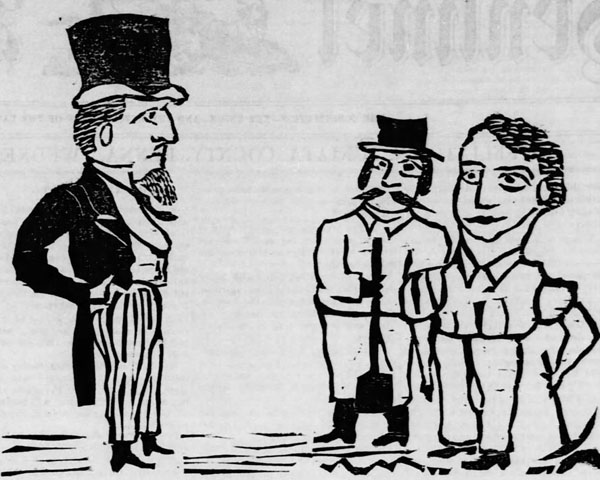
Brother Jonathan,
May 4, 1877, Juanita Sentinel and Republican, Mifflintown,
PA.
Uncle Sam
"Uncle Sam" as a personification for
the U.S. government is cited in a March 24, 1810 journal
entry by Isaac Mayo, then a Navy midshipman. Here is the museum's
transcript:
weighed anchor stood
down the harbour, passed Sandy Hook, where there are two light-houses,
and put to sea, first and second day out most deadly seasick, oh
could I have got on shore in the hight [sic] of it, I swear that
uncle Sam, as they call him, would certainly forever have lost the
services of at least one sailor. (Isaac Mayo - Wikipedia).
This is earlier than the traditional
story that says the term “Uncle Sam” first referred to Samuel Wilson,
a businessman in Troy, New York. That story (reported in an 1830
newspaper article) said that Wilson had been affectionately known
as “Uncle
Sam” Wilson in supplying the United States army with meat during
the War of 1812.
Uncle Sam became an official symbol
of the United States in 1950. Additionally, the story about Samuel
Wilson was apparently so persuasive that in 1961 Congress passed
a resolution in 1961 that recognized “Uncle Sam” Wilson as the namesake
of the national symbol.
Despite that 1961 Congress resolution
I think the Isaac Mayo transcript is the earliest example of Uncle
Sam as a personified name. References
to
"Uncle Sam" began
appearing in 1813 in popular culture but the earliest illustration
is currently the 1832 "Uncle Sam in Danger" lithograph.
Uncle Sam and Brother Jonathan would both be representative "symbols"
of the United States until after the civil war when Uncle Sam's
presence in popular culture started displacing Brother Jonathan.
Pre-1878 Uncle Sam Illustrations
and Examples
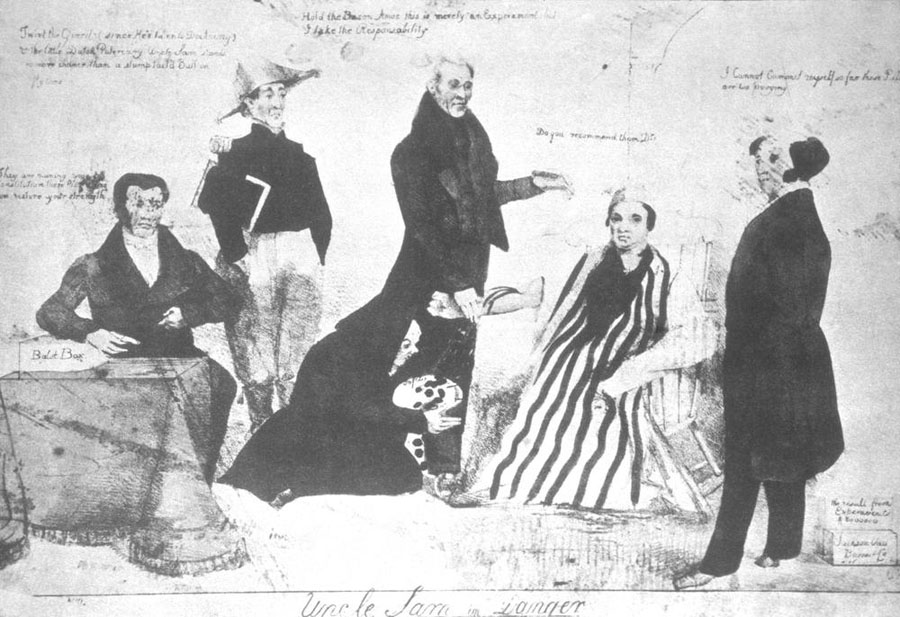
The first drawing of
Uncle Sam discovered so far is "an unsigned lithograph issued
in 1832 and entitled "Uncle Sam In Danger... it conveys the
bitterness over Andrew Jackson's efforts to destroy the Bank of
the United States." Jackson "has just opened a vein in
the right arm of a seated Uncle Sam, who is smooth-shaven, rather
young and attired in a striped robe. (Ketchum, Anton, "Uncle
Sam: The Man and the Legend," Hill and Wang, New York, 1975,
p. 55.)
Lithograph Source: Anonymous,
“Uncle Sam in Danger,” "Presidential Campaigns: A Cartoon History,
1789-1976," accessed November 5, 2023, https://collections.libraries.indiana.edu/presidentialcartoons/items/show/48
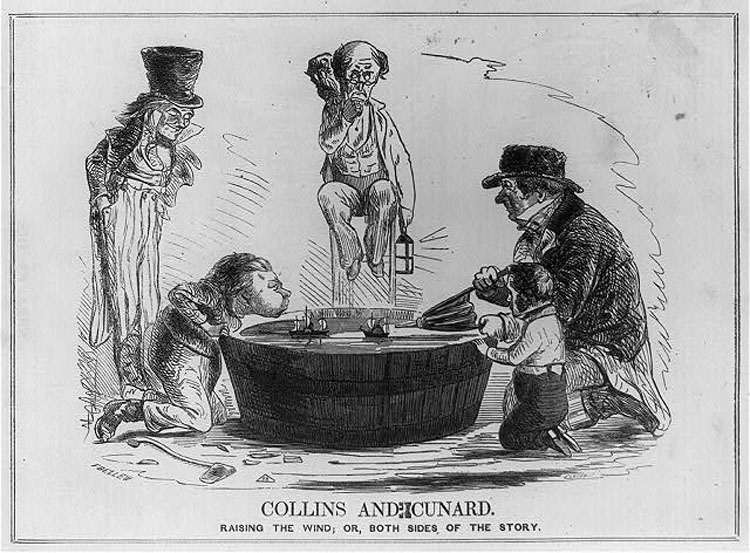
Uncle Sam and John
Bull - Lithograph print by Frank Bellew, The New York Lantern,
March 13, 1852
Caricature of steamship
line competitors Edward Knight Collins (backed by Uncle Sam) and
Sir Samuel Cunard (backed by John Bull) trying to blow toy ships
across tub in opposite directions. (Source: Library of Congress
- Collins and Cunard. Raising the wind; or, both sides of the
story. , 1852. Photograph. https://www.loc.gov/item/2006691886/.)).
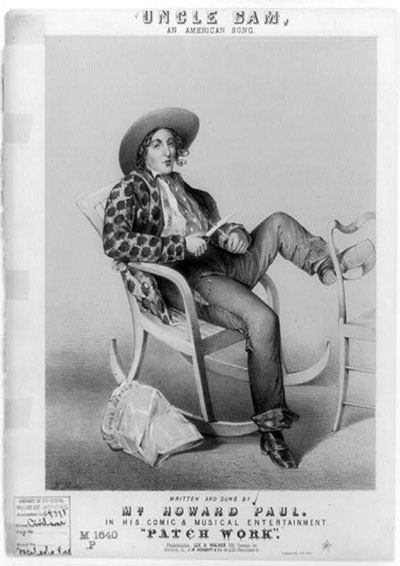
"Uncle Sam, An
American Song" - An illustrated sheet music cover, 1854.
"Uncle Sam here is a young man in a wide-brimmed hat and
patchwork jacket. He sits whittling with his jackknife in a rocking
chair." Courtesy Library of Congress. Also see "The
Whittler for the World,"
Judge, 1899.
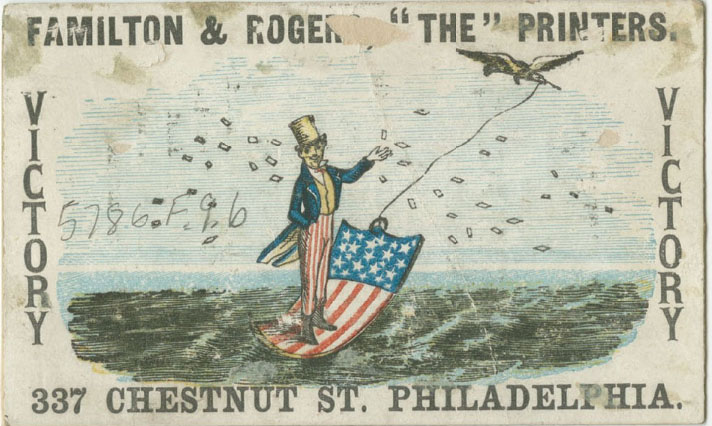
Trade card with Uncle
Sam throwing confetti and being pulled in the ocean on a board
by an eagle. Familton & Rogers (Verso contains military parade
route for February 22, 1862.) (Courtesy of Library
Company of Philadelphia (trade card and close-up
of Uncle Sam).
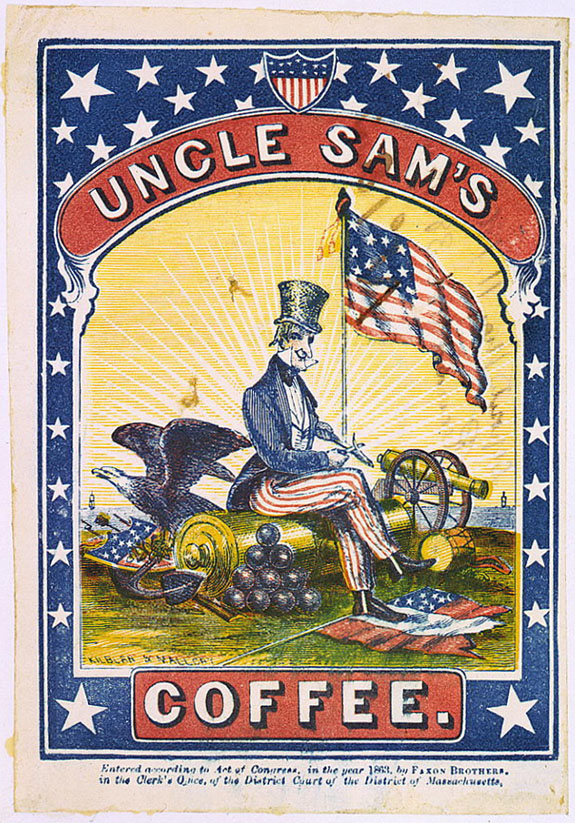
Label for Uncle Sam's
coffee, illustrated with Uncle Sam seated on cannon barrel,
whittling, with foot on torn rebel flag. Kilburn & Mallory, engraver,
c. 1863 (Description and illustration Library
of Congress)
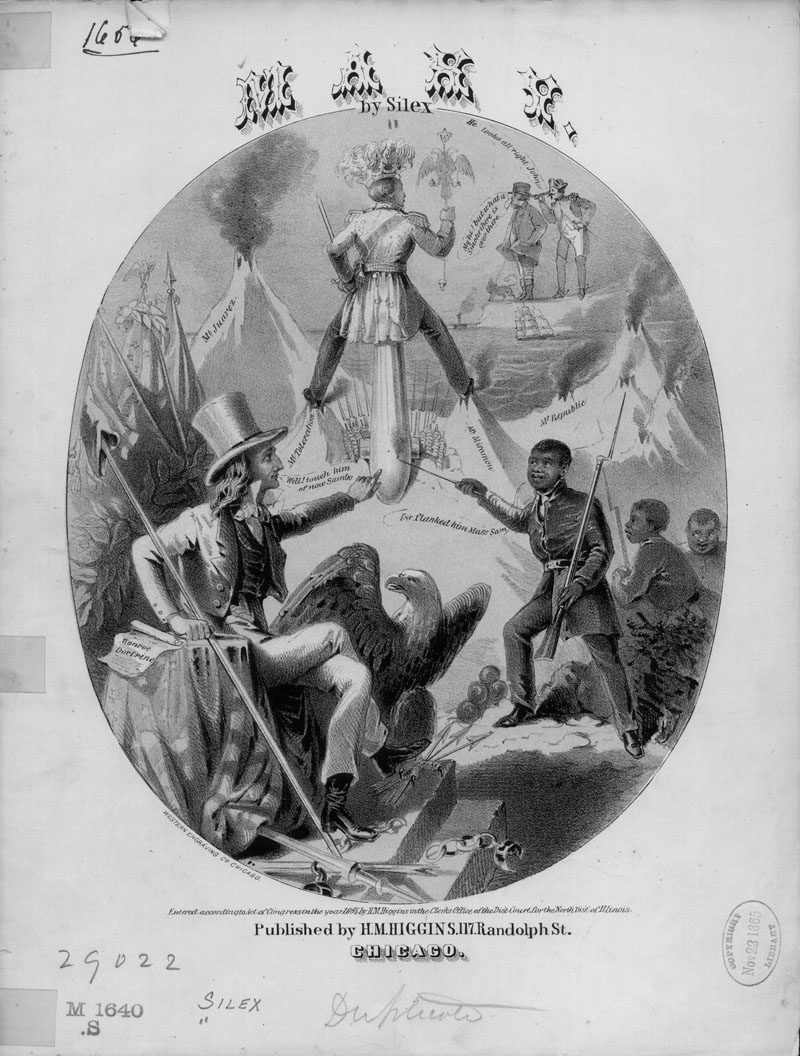
Uncle Sam in "Maxy"
by Silex (composer), Published H. M. Higgins, Chicago, 1865. Sheet
Music (Enlarge size).
(Source: Library of Congress.)
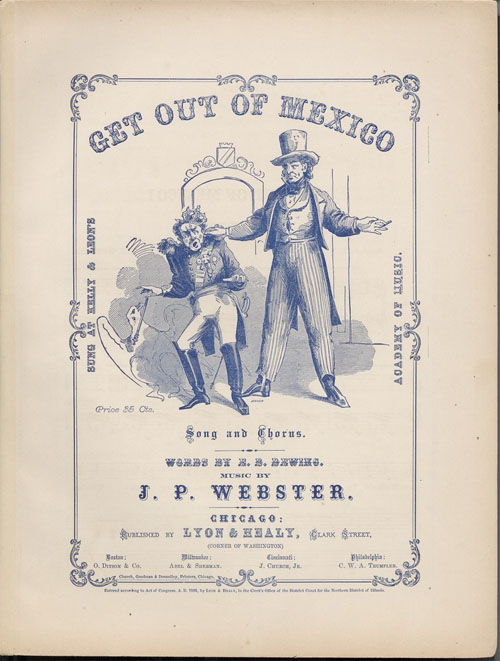
"Get
Out of Mexico" - An illustrated sheet music cover with
Uncle Sam. Published by Lyon and Healy, Chicago, 1866. (Source:
Lester S. Levy Sheet Music Collection, Johns Hopkins.)
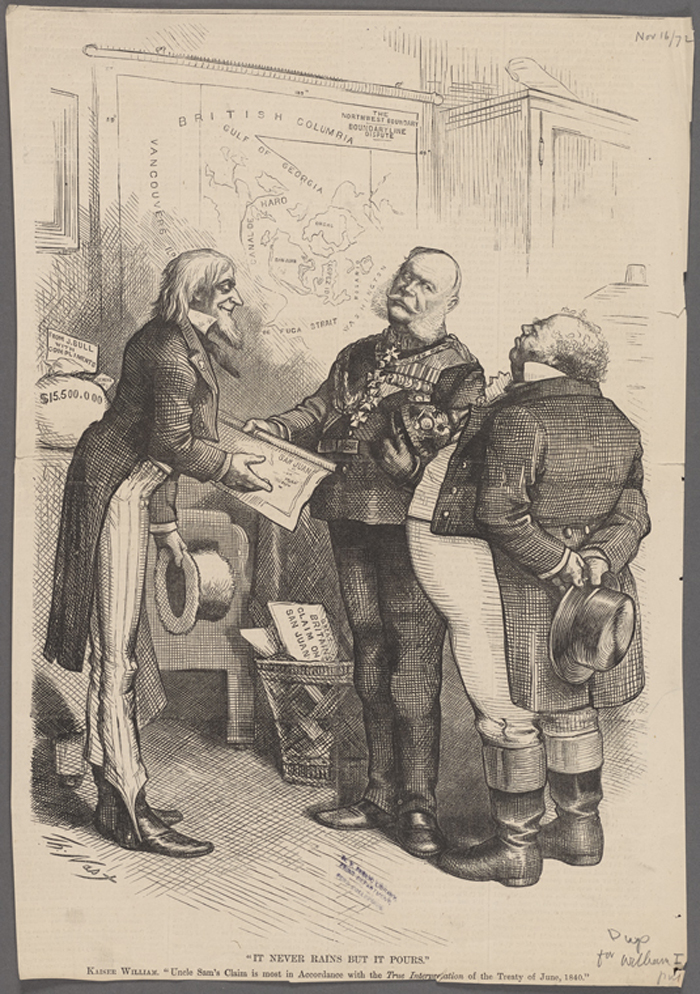
The Morphing of
Brother Jonathan and Uncle Sam
In 1870's the morphing of Brother
Jonathan into Uncle Sam could be seen in American illustrations
but it was also being observed internationally. England's Central
Somerset Gazette noted in their September
28, 1878 issue that "To the European who has studied
Brother Jonathan through the medium of Sam Slick or the broad
caricatures of Yankee Hill, it is a somewhat startling revelation
that the young man who was once Brother Jonathan, but has
now become Uncle Sam...
An 1873 cartoon showing Brother Jonathan
with an American Eagle wounded by “Mormons, Indians, Credit Noblier,
and general dishonesty.” (Wood engraving from Wild Oats newspaper
(New York), March 1873 ), (Source:
Library
of Congress).
Thomas Nast's "Uncle Sam"
illustrations in Harper's Weekly in the 1870's also helped
create the updated Uncle Sam. As Braun described in "Before
America Got Uncle Sam, It Had to Endure Brother Jonathan"
Uncle Sam had long
existed alongside Brother Jonathan, but as a less prominent character.
During the Civil War, American and British cartoonists started dressing
Uncle Sam in the long-tailed blue coat and red-and-white striped
trousers that had been worn by Brother Jonathan. At the same time,
Uncle Sam started to acquire Lincoln-like aspects, including as
a stovepipe hat and a sizable beard. Eventually, Brother Jonathan
faded entirely into the figure of Uncle Sam who became the stoic,
sober, adult version of the American government that was needed
in the wake of the war.
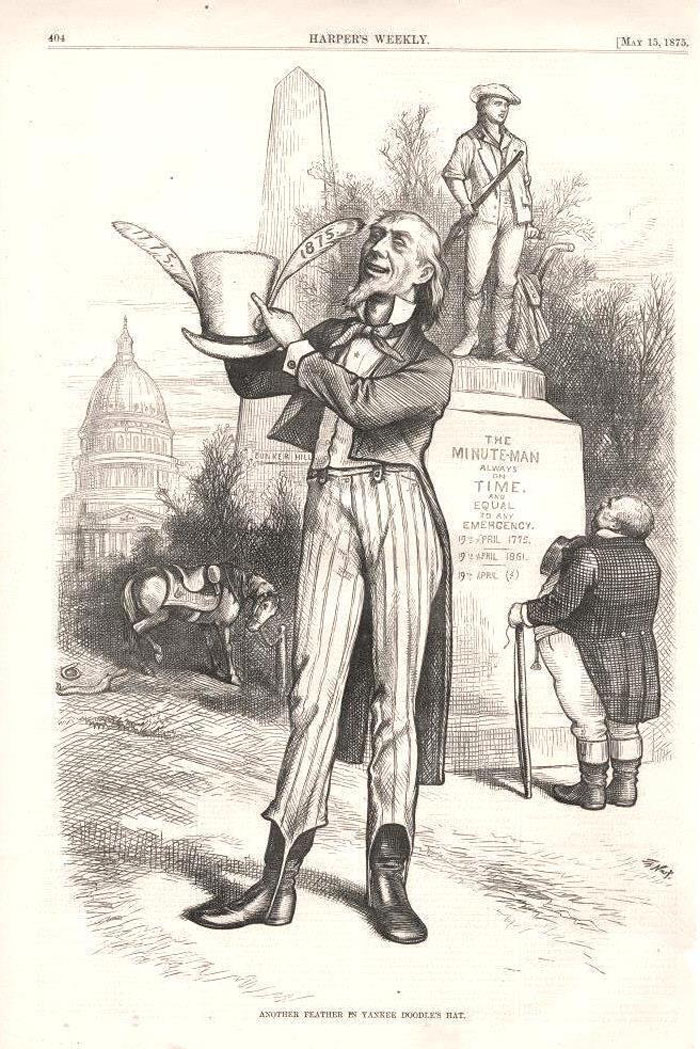
"Another Feather in Yankee
Doodle's Hat," by Thomas Nast, Harper's Weekly,
May 15, 1875
Nast's illustration of Uncle Sam in
the May 15, 1875 edition of Harper's Weekly exemplifies the
direction of the new Uncle Sam in becoming the primary personification
of the United States government in American popular culture, with
Nast adding a "Yankee Doodle" feather for Uncle Sam's
hat.
The
following woodcut from Harper's Weekly in 1882 takes the
most symbolic parts of America (the American Eagle and Uncle Sam)
to create a composite representative of the United States for negotiating
with the British. Being John Bull's counterpart in popular culture
illustrations would continue to move towards that being Uncle Sam,
not the previous common scenes of Brother Jonathan and John Bull.

Negotiations
between the British Lion (John Bull) and Uncle Sam, Harper's
Weekly, 1882.
In a fisheries dispute with Canada
which went against the United States, the American representative
Mr. Kellogg sought to invalidate the decision since he said
it was not unanimous. Brother Jonathan, defending the US position
says "Crawl out of that loophole? Hunkerslide? Never!"
Grip, December 1, 1877.
See Phonographia's Brother
Jonathan and Uncle Sam - Canadian Caricatures
1849 - 1878 for more examples in Canadian popular
culture of how Brother Jonathan and Uncle Sam were seen, as
documented in A Caricature
History of Canadian Politics.
John Bull and
Uncle Sam, Puck, November 1888
By the late 1880's
Brother Jonathan's limited future as a distinct character in popular
culture was clear with John Bull and Uncle Sam now depicted as
the respective symbols for the United States and Great Britain,
not John Bull and Brother Jonathan.
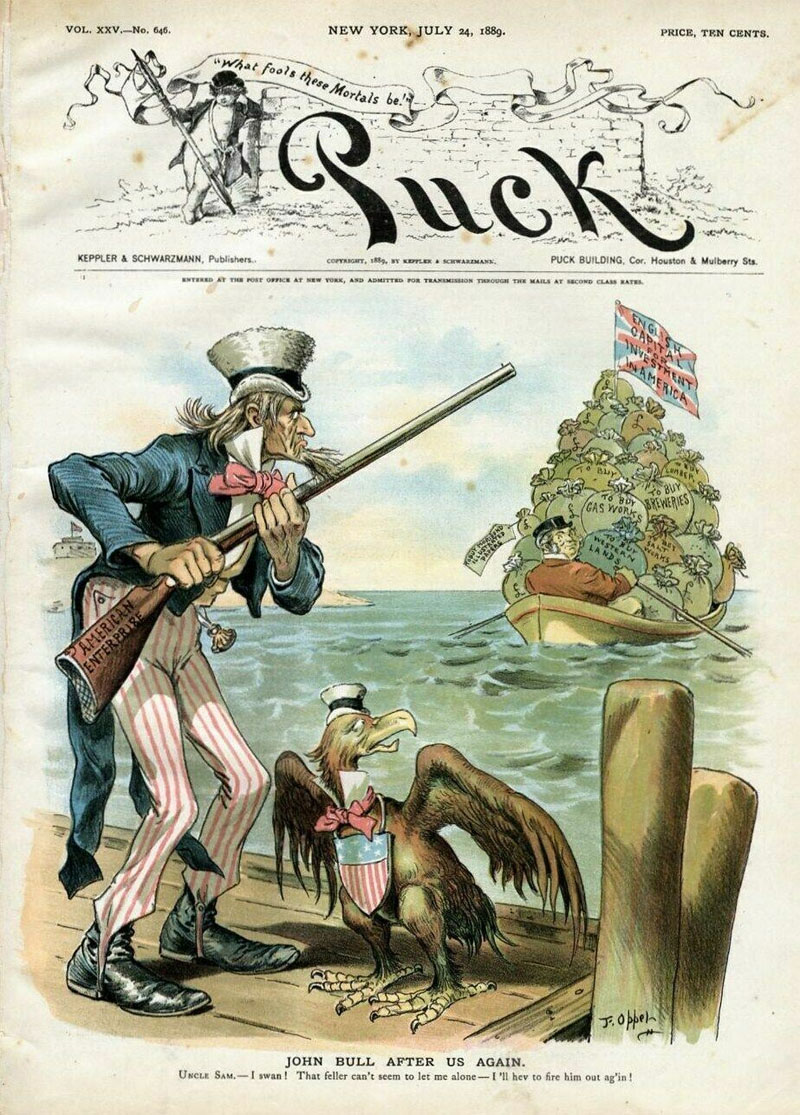
John Bull and
Uncle Sam, Puck, July 24, 1889 - Uncle Sam defending
American Enterprise.
Brother Jonathan
and Uncle Sam Promoting Mrs. Potts' Sad Irons
Four Mrs. Potts' Sad Iron ads from
1877 and 1878 are significant in this 'investigation' based on their
commonality of time period, because of the figures which were identified
as Uncle Sam and Brother Jonathan, and because they were all promoting
Mrs. Potts' Sad Irons.
Two of those Mrs. Potts' Sad Iron
newspaper advertisements are particularly interesting since they
were published in Frank Leslie's Illustrated Newspapers only
three weeks apart (May 11, 1878 and June 1, 1878) - one with an
identified Uncle Sam, the other with an unidentified figure.
The first and the earliest of the
four Mrs. Potts' Sad Iron ads
pre-1878 were released during or shortly after the Centennial International
Exposition of 1876 in Philadelphia). One trade card showed Miss
Columbia ironing a hat
in her kitchen with her Mrs. Potts' Sad Iron. Miss Columbia speaks
to the figure in the kitchen who owns the hat and identifies him
as Brother Jonathan. His chin is very pointed. His blue coat
has stars and his red striped pants reveal aspects of the morphing
process of Brother Jonathan with Uncle Sam. His nose, smile, and
full face have some commonality with the June 1, 1878 Mrs. Potts'
Sad Iron ad where the unidentified figure is turning the crank of
an Edison phonograph and the Czar of Russia is listening in astonishment.
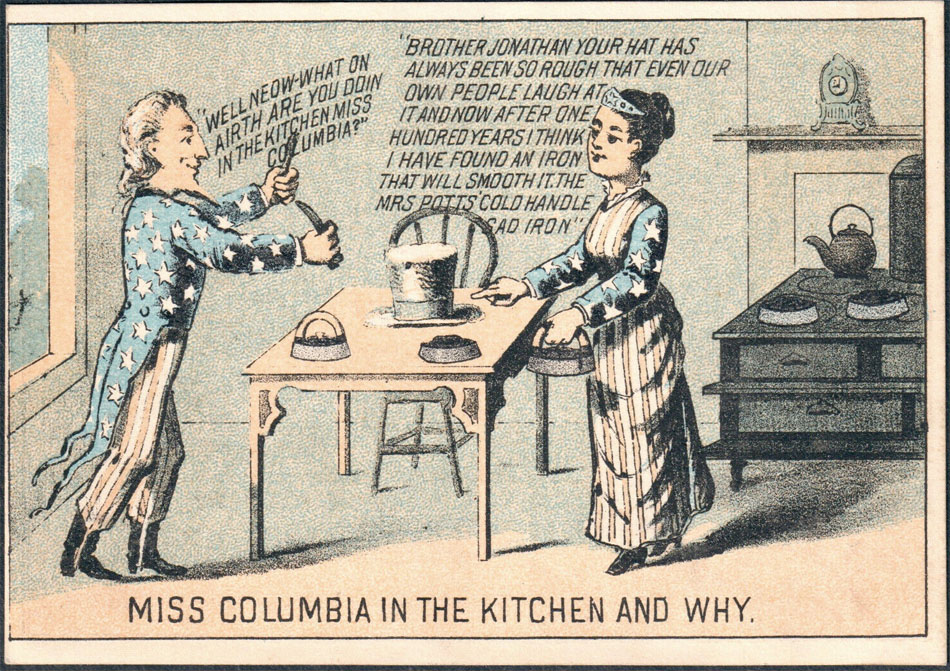
Miss Columbia and Brother Jonathan
in the kitchen with Mrs. Potts' Cold Handle Sad Iron. Sold
by Burditt & Williams, Boston, Mass. The 1876 Centennial International
Exposition in Philadelphia displayed the Mrs. Potts' Cold Handle
Sad Iron. Click
to see back of this card.
Another tradecard from 1876 also
showed Miss Columbia and Brother Jonathan advertising Mrs. Potts'
Cold Handle Sad Iron next to a table in a domestic scene with
Brother Jonathan casually stretching out his legs on the table.
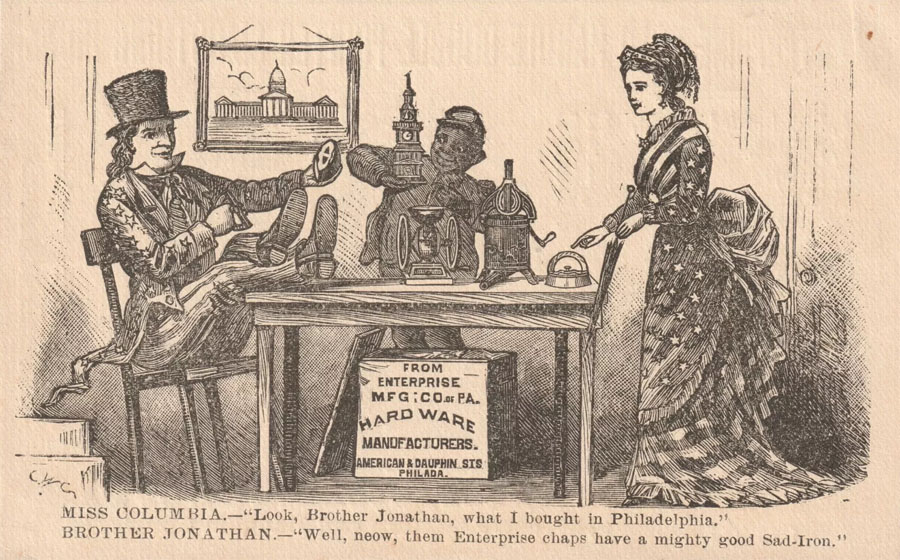
Brother Jonathan holding
Mrs. Potts' Sad Iron made by Enterprise Mfg. Co. - Tradecard from
1876 Philadelphia Exposition. Card courtesy of Don Cheadle Card
Store. (Click
to see reverse).
The Mrs. Potts' Sad Iron ad in the
May 11, 1878 Frank Leslie's Illustrated Newspaper identified
Uncle Sam as holding the Sad Iron while revealing his plan to
the Crowned Heads of Europe on how to "smooth out the map
of Europe."
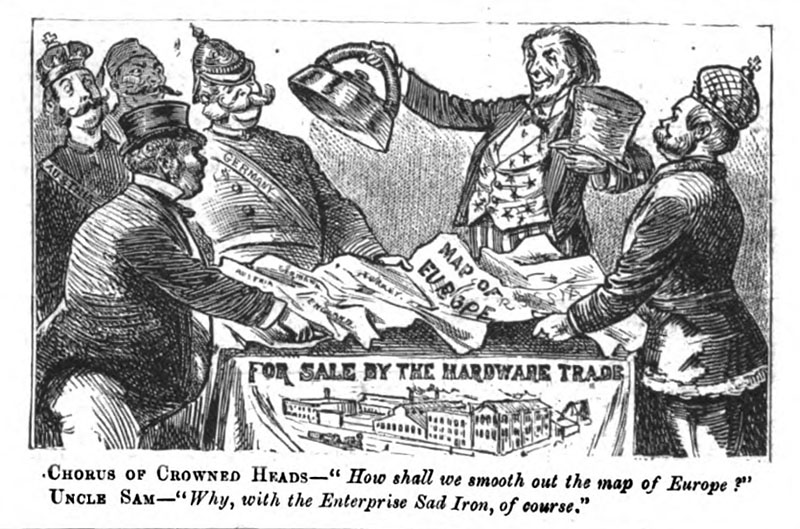
Uncle Sam in an advertisement for
Mrs. Potts' Sad Irons, Frank Leslie's Illustrated Newspaper,
May 11, 1878. John Bull is on the left.
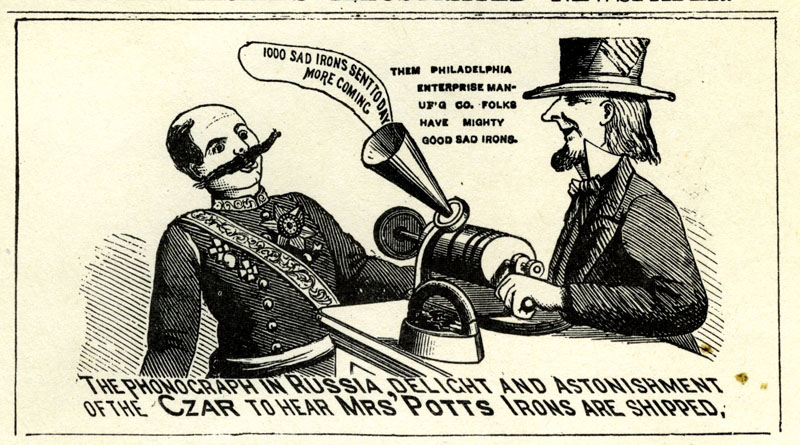
Frank Leslie's Illustrated Newspaper
advertisement for Mrs. Potts' Sad Irons, June 1, 1878 shows
the Czar clearly delighted and astonished by Edison's phonograph.
The operator of the phonograph is not identified, but his role is similiar to the May 11, 1878 ad where Uncle Sam is using the Enterprise Sad Iron to "smooth out the map of Europe", in this case he is sitting with the Russian czar who didn't have a seat with the Crowned Heads of Europe.
Is Brother Jonathan the Unidentified
Phonograph Operator?
Comparison of Clothes and Personal
Features/Attributes
The Unidentified Phonograph Operator's
pants can't be seen and his coat is black. His hat is much shorter
than Uncle Sam's hat.
The Uncle Sam with the Crowned
Heads of Europe has unkempt hair going over his ears, his eyes look
older and his face narrower than both the Brother Jonathan in
the Kitchen and Unidentified Phonograph Operator. The
Unidentified Phonograph Operator's more prominent nose, wider
and younger looking face, open and engaged eyes, and slightly turned
up smile also add some leanings towards the identity of Unidentified
Phonograph Operator being Brother Jonathan.
The two cards of 1876 showed clean
shaven Brother Jonathans welcoming guests to the Philadelphia World's
Fair. This was a look he had in most of his illustrations prior
to the civil war. Nevertheless, the Unidentified Phonograph Operator
ad is similar to the Brother Jonathan with his goatee in the
1873 illustration "Badly Used Bird" and during this period
Brother Jonathan began to be seen more commonly with his goatee
(or even a little more on his chin).
The illustration from the May
4, 1877 letter from the "Citizens to Brother Jonathan"
is a more crudely drawn bearded Brother Jonathan but it does have
features resembling the Unidentified Phonograph Operator.
Personas/Roles interpreted from
Audiences/Settings
The audiences and settings in these
three ads are significant in relation to Uncle Sam and Brother Jonathan's
respective personas of the time and useful in identifying the mystery
phonograph operator.
Audience #1 and Audience
#2 circa the 1876 Exposition both have Miss Columbia by a table,
with one identified as a Kitchen. Miss Columbia is ironing Brother
Jonathan's hat with her Mrs. Potts' Sad Iron.
Brother Jonathan finding Miss Columbia
in the kitchen is a surprise but when asked why she's in the kitchen
Miss Columbia says she is looking out for Brother Jonathan's reputation
since he is known for having a hat that is rough and people have
laughed at him for this - so she's ironing his hat.
The kitchen and Brother Jonathan
being there in the kitchen with Miss Columbia makes this a
"social scene" between friends with Columbia showing
concern for Brother Jonathan and how he appears and is perceived
in public.
Likewise the other 1876 Exposition
related card has the same social and friendly scene between Brother
Jonathan and Miss Columbia.
Audience #3 are the Crowned
Heads of Europe with Uncle Sam showing them how to smooth out
the map of Europe. The time period is just before the Congress
of Berlin which set the terms following the end of the Russo-Turkish
war. In the summer of 1878 Russia was "feeling
diplomatically isolated and verging on financial and military exhaustion."
Uncle Sam with Crown Heads of Europe
is Uncle Sam playing his role in "International Politics"
with Uncle Sam, the symbol of government and representative of the
United States of America, meeting the the Crowned Heads of Europe
who had also just helped keep Constantinople from falling to Russia
(primarily because of England's Naval presence - see John Bull at
the table with Uncle Sam looking directly at him in the May 11,
1878 Mrs. Potts' ad.)
The following Harper's Weekly cover
from May 25, 1878 also emphasizes that Uncle Sam is now commonly
seen in cartoons involving international politics, treaties and
national financial matters (with numerous other examples also making
that point by not displaying Brother Jonathan with John Bull).
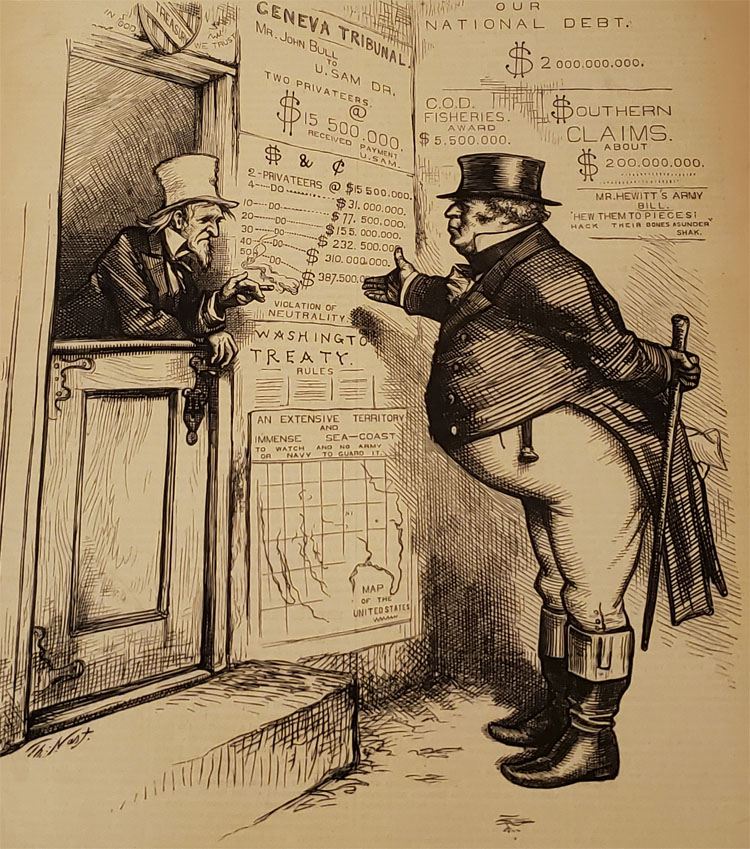
"Revenge is
an Expensive Luxury." Thomas Nast, Harper's Weekly,
May 25, 1878
John Bull to Uncle
Sam: "No doubt, you are now glad that "the indirect claims"
were thrown out at Geneva."
Audience #4 is
the Czar with the Unidentified Phonograph Operator who is
there in the role of support for American products and in particular
the sales made by Mrs. Potts' Sad Irons in her business deal with
the Czar of Russia. Brother Jonathan was known for his "abilities
in international commerce," for his interest and involvement
in the consumer marketplace, for being a factor "in the markets"
and "pushing his wares," and for getting things done.
The Unidentified Phonograph Operator
is playing his role of supporting American Enterprise and
American products by being with the Czar of Russia and delivering
Mrs. Potts' message that her American made Sad Irons have shipped,
with more on the way.
|
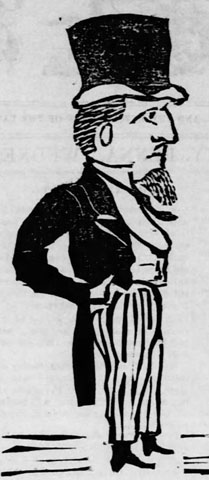
May 4, 1877
Juanita Sentinel
and Republican
|
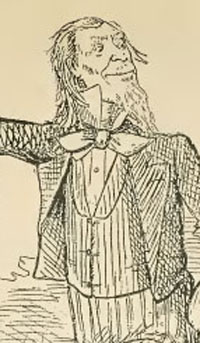
December 1,
1877, Grip
|
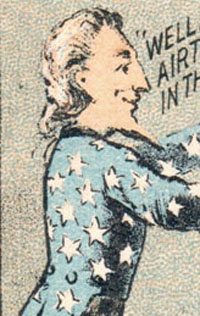
ca.1877
Trade card for
Mrs. Potts' Sad Irons
|
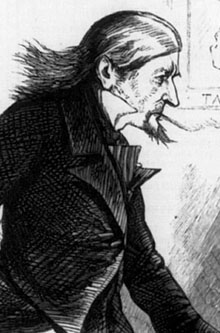
Wild Oats
Newspaper (New York) March 1873
|
All of the above were identified in
illustrations as Brother Jonathan
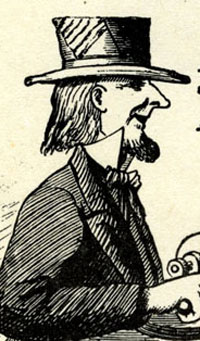
|
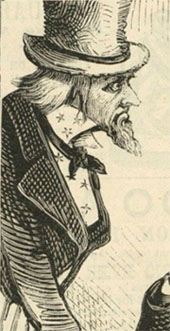
January 9,
1875
Frank Leslie's
|
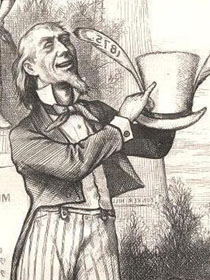
May 15, 1875
Harper's
Weekly
|
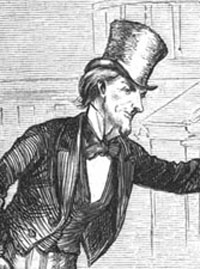
May 4, 1878
Frank Leslie's
|
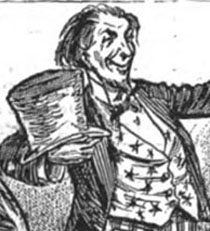
May 8, 1878
Frank Leslie's
|
All of the above were
identified in illustrations as Uncle Sam
Identity
Suggestion: Uncle Sam, the morphed Brother Jonathan.
The unidentified phonograph
operator has some similarities with cheek, hair, eye and mouth
features with various identified Brother Jonathans; likewise the
shorter hat, no white shirt cuffs showing, the beard, nose similarities
and a general countenance seem to match more of the identified
Brother Jonathans than the Uncle Sams.
But all of these similiarities are to be expected since the morphing of figure and roles is becoming more complete into Uncle Sam being the representative of the United States. If simply comparing the figures in the two Mrs. Potts Sad Iron Ads in Frank Leslie's Illustrated Newspaper of May 8, 1878 and June 1,
1878 (published just three weeks apart), the unidentified figure
turning the phonograph crank is similiar and it's only three weeks between these ads. The figures could have been done by different artists but the twenty-one day timing in the same periodical suggests that the ad was intended to represent Uncle Sam, albeit as the morphed and role-playing salesman associated with Brother Jonathan.
Furthermore, when looking at the number of identified figures of Uncle Sam in "Frank Leslie's Illustrated Newspaper" in 1878, with few Brother Jonathans, the transformation is evident that Uncle Sam has become the primary symbol of the United States of America in popular culture.
The roles are revealing because the Unidentified
Phonograph Operator is acting to support a business transaction
of goods, something tradionally associated with Brother Jonathan. At this time
the common personified realm of Uncle Sam was his involvement with international financial deals involving public debt
or government financial policy, not ordinary business transactions. But again, 1878 seems to be a significant morphing year for all roles to start being assumed by Uncle Sam.
Additionally, the
ad with the Czar seems to be cordial but definitely selling a consumer
item (much like the two Brother Jonathan tradecards circa the 1876
Philadelphia Exposition.) This domestic and friendly relationship
between Jonathan and Columbia support the Brother Jonathan's role in operating a phonograph as a
business deal with the Czar of Russia -- also
remembering that this ad was in the newspaper during the time that
Russia was involved with the Congress of Berlin -- meaning
Uncle Sam and Crowned Heads of Europes would have been on the opposing
side of Russia in those treaty negotiations.
Although there are many reasons to say that the unidentified figure could be Brother Jonathan I think we are in the time of change where morphing figures now are being seen as Uncle Sam, unless Brother Jonathan is specifically named in the illustration.
|

Uncle Sam,
May 8, 1878, Frank
Leslie's Illustrated Newspaper
|
|
Brother Jonathan,
June 1, 1878, Frank
Leslie's Illustrated Newspaper
|
In short, even if it's not Brother
Jonathan (as it's admittedly uncertain with no specific identification
in the illustration and it being during the Uncle Sam morphing era)
it's still an opportunity to remember Brother Jonathan's place in
American popular culture and how he contributed to the overall position that Uncle Sam would assume.
Before the Revolutionary War Brother
Jonathan was a personification/designation for American colonists,
particularly for New Englanders and Yankees. As he developed into
a character he would become a representative/symbol of the United
States and so prominent that it was Brother Jonathan who would be
seen in many cartoons and illustrations, face to face with John
Bull. After Brother Jonathan morphed into the post-civil war Uncle
Sam and Brother Jonathan would eventually disappear as a character
withd most people today not knowing his name.
Whether it's Uncle Sam or Brother
Jonathan isn't the critical fact to Friends of the Phonograph
since either way the Mrs. Potts' ad is the first of its kind in
popular culture to show a 'representative' of the United States
enjoying the infant tinfoil Phonograph. The Phonograph was
also clearly delighting and amazing the Czar of Russia.
It's an historic and novel use of
the Edison's new "wonder" and a fun example of phonographia.
FACTOLA: The
earliest example of a phonograph
being part of an advertisement, but not with the intention of
selling a phonograph in that ad, is the June 1, 1878 illustration
in Frank Leslie's Illustrated Newspaper. In this ad Uncle Sam/Brother
Jonathan (a symbol of the United States in general, and an allegorical
figure of U.S. capitalism) is promoting the export of Mrs. Potts'
Sad Irons to Russia by bringing the message to the Czar of their
pending delivery by means of the recently invented Edison tinfoil
phonograph.
There are two other interesting connections
to the Mrs. Pott's ads:
FACTOLA: Uncle Sam, Brother
Jonathan, and the President of the United States Rutherford B. Hayes
were each seen in an advertisement in Frank Leslie's Illustrated
Newspapers promoting Mrs. Potts' Sad Irons within three weeks
of each other: Uncle Sam (May 11, 1878), Brother Jonathan/Uncle Sam (June
1, 1878) and President and Mrs. Hayes (May 18, 1878).
FACTOLA: On April 18, 1878
and into the morning of April 19, Thomas Edison demonstrated the
Edison tinfoil phonograph to President and Mrs. Hayes at the White
House making President Hayes the first president of the United States
and the first head of state of any country to hear the phonograph
and its recorded sound.
The backstory: Edison received word
around eleven at night that President Hayes would be glad to have
a demonstration that night. It went so successfully that "at
about half-past twelve, when it was expected he would leave, the
President suggested that Mrs. Hayes and her friends should hear
the talking machine. They were aroused from their beds and only
after another three hours was Edison allowed to leave."
("Edison The Man Who Made the Future," Ronald W.
Clark, G.P. Putnam's Sons, New York, 1977, p. 81).
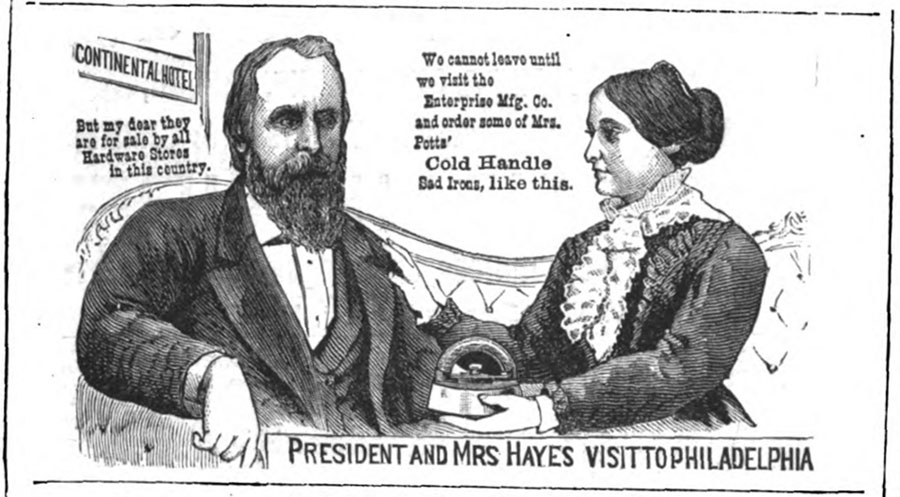
President and Mrs. Hayes
in an advertisement for Mrs. Potts' Sad Irons, Frank Leslie's
Illustrated Newspaper, May 18, 1878.
For more illustrations which identify
Uncle Sam and Brother Jonathan by name see "Uncle
Sam and Brother Jonathan Illustrations
-- Frank Leslie's Illustrated Newspaper and Harper's Weekly,
1875 - 1878."
Uncle Sam and
Brother Jonathan: Salesmen 1876 - 1900
This section is a broader gallery
of American consumerism being supported by the morphing roles
of Brother Jonathan and Uncle Sam.
Brother Jonathan had originated
as a regionalist Yankee and was the personification of New England.
He became a symbolic figure of the United States in general, and
"an
allegory of capitalism."
The United States civil war changed
popular culture and the revised personification of Uncle Sam was
part of the change to reunify the country.
Post civil war Uncle Sam became
the Uncle Sam of the federal government and political matters.
Post civil war Brother Jonathan
became less political in his more socially oriented man-of-the
people representation of the United States as seen in his welcoming
of visitors to the first World's Fair in the United States in
1876. Brother Jonathan would also be seen for his roles in trade,
commerce, and the promotion of consumer products.
There is an interesting distinction
of roles identified in a Wikipedia
article
which cites an article in the 1893 The Lutheran Witness
(December 7, 1893 "A Bit of Advice" The Lutheran Witness
p. 100) providing the following role clarification for the same
person:
Brother Jonathan and Uncle
Sam were different names for the same person: "When we meet
him in politics we call him Uncle Sam; when we meet him in
society we call him Brother Jonathan. Here of late Uncle Sam
alias Brother Jonathan has been doing a powerful lot of complaining,
hardly doing anything else."
I like the different names, same
person idea because it also includes different roles for each
name which can be illustrated situationally. References to Brother
Jonathan at a
Children's Carnival and Ballet or being personified as the
potential partner in a marriage with Canada are in contrast with
Uncle Sam's political personification with Congress, his relationship
with the President and with the details of the United States government.
Remembering the May 4, 1877 letter
from the "Citizens of the United States" to "Brother
Jonathan, or rather the government" it's also clear that
Brother Jonathan was still part of political conversations in
popular culture and a symbol of the country at the end of the
1870's.
This, of course, changed and the
hundreds of illustrations and covers of magazines like Puck
and Judge are evidence that Uncle Sam between the 1880's
to 1900 became the symbol and personification of the United States
government and respective political matters with Brother Jonathan
disappearing.
By the end of the century Uncle
Sam would also be the only one of the two giving endorsements
for US products that wanted Uncle Sam as their sales representative.
The Gallery of
Endorsements made by Brother Jonathan and Uncle Sam: 1876 - 1900
The following gallery displays advertising
trade cards, lithographs and advertisements. In the 1870's and early
1880's there are some examples which do not name Uncle Sam as the
symbol that is doing the selling. Like the Mrs. Potts' June 1,1878
figure with the phonograph it's possible that Brother Jonathan was
being used and recognized in popular culture ads longer than we
now assume.

Brother Jonathan celebrates the American
centenary by straddling the towers of the main building at the Philadelphia
Centennial Exposition of 1876. Printed by Currier & Ives, c1876.
Courtesy Library
of Congress.
"It was the Age of Marvels as
any of the nearly 9 million visitors to the Centennial Exposition
could attest. Of all the wonders in evidence that spring of 1876
none was more astonishing than Alexander Graham Bell's telephone,
a revolutionary device that converted sound waves into an electrical
signal and promised to replace the telegrapher's dots and dashes
with the of the human voice." (WATCH
Video excerpt from PBS's American Experience "From
the Telephone and Telegraph Comes the Phonograph").
This 1876 World's Fair in Philadelphia
had four products on display with significant connections to the
soon-to-be invented Phonograph: The typewriter, the sewing machine,
the telephone and Edison's electric pen. For sewing machines awarded
at the 1876 Centennial Exposition see Fiddlebase
- "Sewing
Machines awarded at the Exhibition 1876."
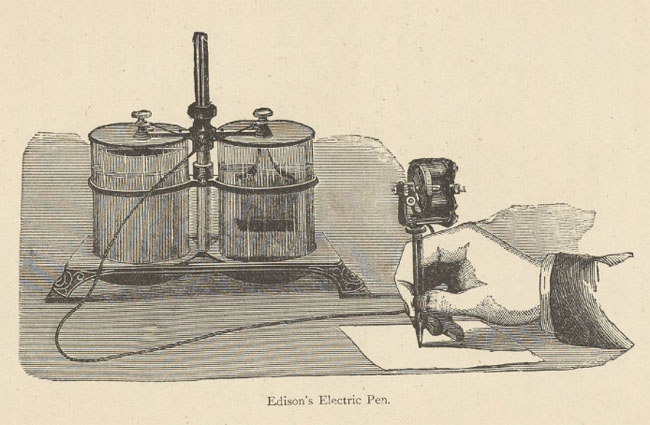
See Edison's
Electric pen for more details about the pen and about Edison’s
agent George W Caldwell exhibiting the pen at the 1876 Centennial
Exposition in Philadelphia (Courtesy FTL Design - History of Technology).
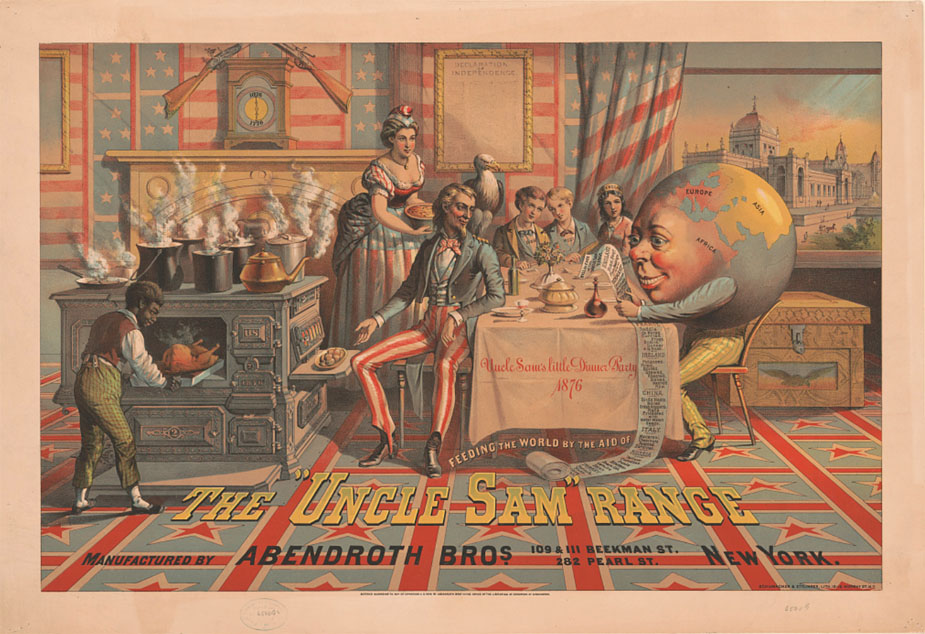
The Uncle Sam Range, 1876 (Courtesy
Library of Congress) (Enlarge)
Clark's Spool Cotton, Gold Medal Awarded,
Paris 1878. Lithograph by L. Prang & Co., Boston, U.S.A. ©1878
(Uncle Sam or Brother Jonathan?)
Ladies Pocket Calendar for 1879 on back
of trade card.
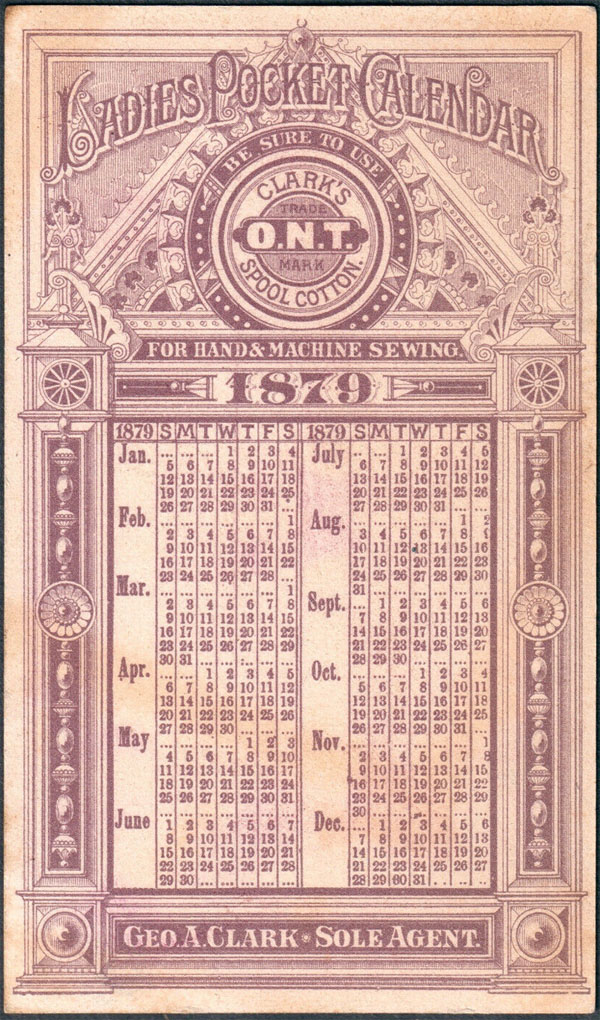
Clark's Spool Cotton,
Gold Medal Awarded, Paris 1878. Lithograph by L. Prang & Co.,
Boston, USA ©1878 Uncle Sam (or Brother Jonathan) with Miss Columbia
- Calendar for 1879 on reverse of trade card)
Bell Telephone Communication Calendar
for 1881, Lehman & Bolton, lithographers. Philadelphia, 1880 (Courtesy
of Library
Company of Philadelphia.)
The Library Company of Philadelphia's
description identifies the woman as Liberty with a lyre at her feet
as she looks at an album of US Presidents. The man holding the album
is not identified but this is clearly Brother Jonathan with his
clean shaven face and morphing role with Uncle Sam (which seems
supported by his Philadelphia World's Fair of 1876
illustration straddling the towers of the main building).
The Improved Howe Scale
with Brother Jonathan (not identified but beardless), 1880's, Made
by the Howe Scale Co., Rutland, VT. USA
Not specifically identified
but the striped pants, the hat, no beard and his activity make this
advertisement for Nathaniel W. Appleton, a Boston Stationer, more
likely the New Englander Brother Jonathan than Uncle Sam. Here Brother
Jonathan is seen drinking hard cider from a barrel in an ad printed
by Wemple & Kronheim, N.Y. circa 1880's.
Hinds' Honey and Almond Cream Trade
Card, 1880
A Handy Fellow Sweet
Golden Seal Cigarette Trade Card, 1881 with puzzle on other side.
Printed by Hatch Lith. Co. New York. (Courtesy Dave Cheadle)
Uncle Sam (fuller beard
and stars on hat) advertising Preston & Merrill's Yeast Powder
trade card, printed by Bancroft - Lith - S.F. circa 1880's. (Courtesy
Dave Cheadle)
Brother Jonathan or
Uncle Sam? Circumstances of the room would suggest it's Brother Jonathan
as a tradesman or traveling salesman. Frank Miller's Blacking, Trade
card by Mayer, Merkel & Ottmann, Lithographers, NY, circa 1880's.
.
Uncle Sam (or Brother
Jonathan?) offering Libby's Cooked Corned Beef to England. Trade card
circa 1876 Philadelphia Centennial Exposition. (Courtesy Dave Cheadle
Cards)
Uncle Sam promoting Henry
Mayo & Co., Boston Minced Codfish, circa 1880's (since he's identified
in the following ad for "Uncle Sam's Reward.")
Uncle Sam promoting Henry
Mayo & Co., Boston Minced Codfish, circa 1880's
Is this Uncle Sam or
Brother Jonathan promoting Oliver Chilled Plows, South Bend, Ind.,
circa 1880's? If it's Uncle Sam then the rascally and 'social' Brother
Jonathan has been morphed here into Uncle Sam using Brother Jonathan's
role previously seen in his involvement in an international courtship
(i.e., Canada
annexation cartoon in 1869). Brother Jonathan's earlier
role as the foil of John Bull is also present in this ad since the
international skirmish is displayed as a "Victory" over
the disappointed John Bull.
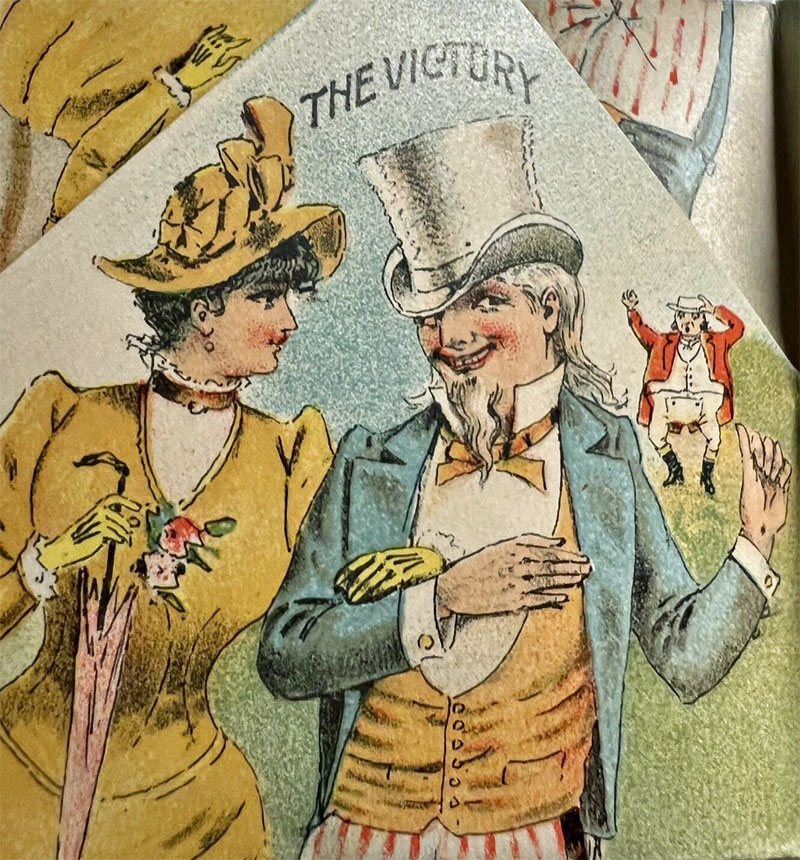
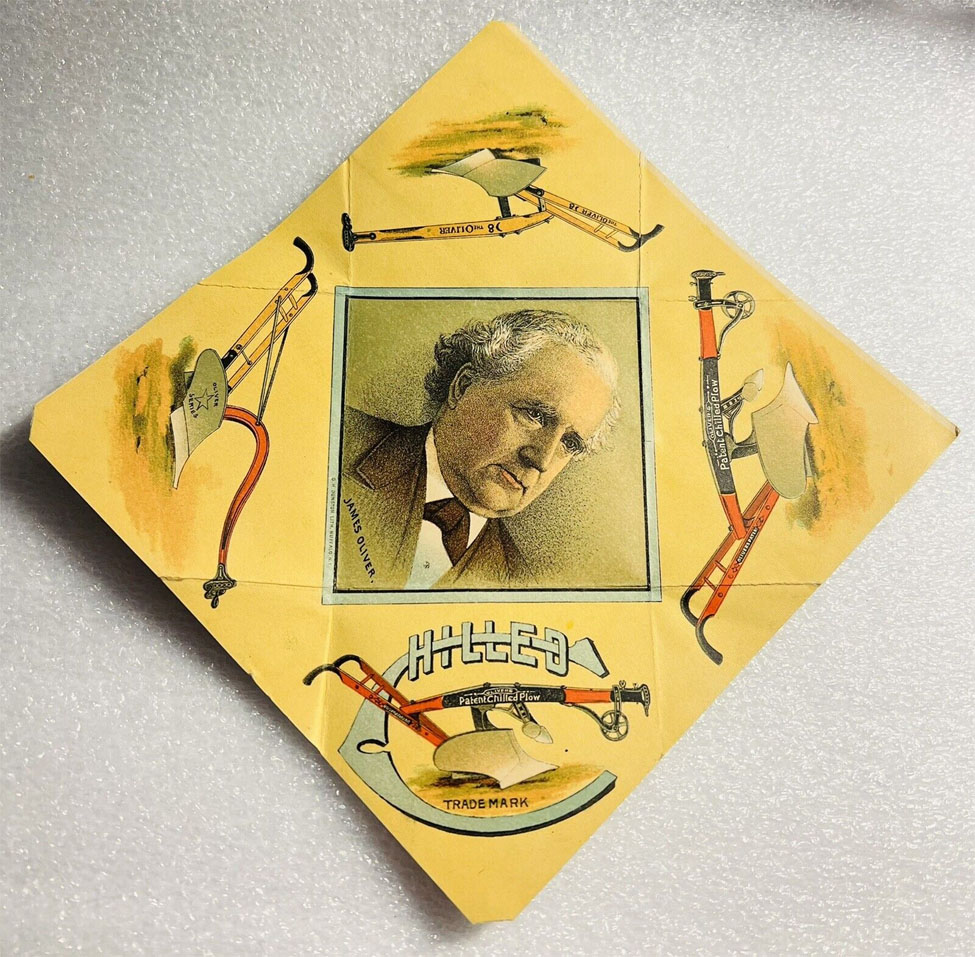
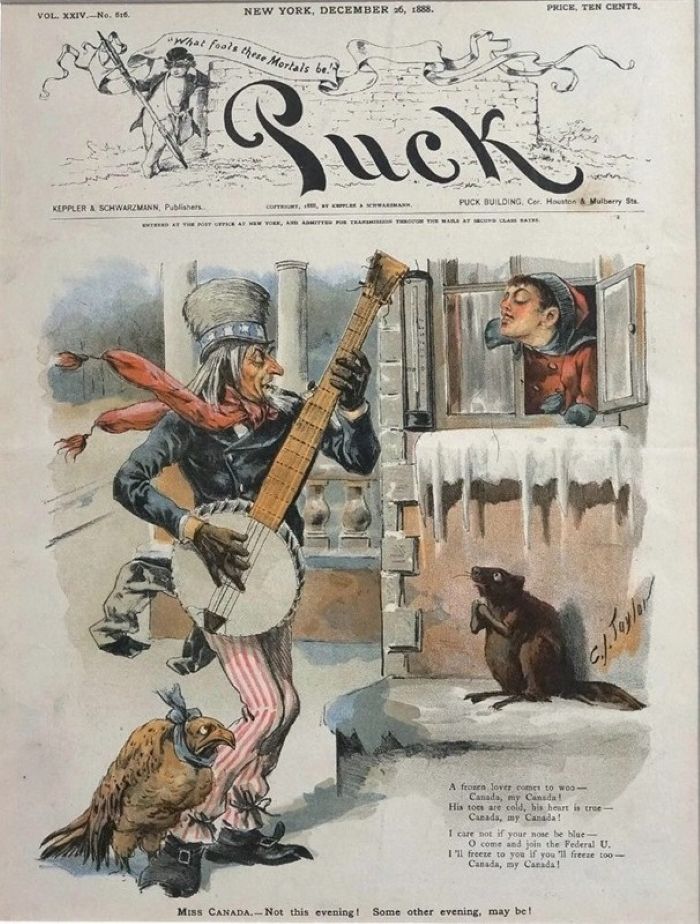
Another Wooing attempt on Miss Canada by Uncle Sam, "Puck" December 28, 1888.
Uncle Sam promoting the
New "Model Grand" Portable Range. Spicers & Peckham,
Providence., R.I. trade card by Mayer, Merkel & Ottmann, Lith.,
New York circa 1880's. (Disclaimer)
Uncle Sam at the North Pole promoting
Soapine Soap. c. 1880s. "Yankee Notions" is probably more
in character with Brother Jonathan's New England regionalism and
commercialism.
Uncle Sam promoting the B. T. Babbitt's
Soap Powder, New York. Trade card by Bufford, circa 1880's.
Ca. 1883 Ivory Soap advertisement
from the booklet "What a Cake of Soap Will Do." National Museum
of American History, Behring Center, Bathing (Body Soaps & Cleaners)
Collection. (Disclaimer)
Uncle Sam (giving advice
to "buy it") promoting Clark's O.N.T. Spool Cotton thread,
circa 1880's.

Uncle Sam (giving advice) promoting
"Empire" Wringer, trade card circa 1880's.
Trade card of Uncle Sam
with stars on his hat and holding a cigar, and parodied as an opportunistic
salesman. Inspired by Oscar Wilde's Tour of United States and the
aesthetic movement, ©1882 by E.B. Duval. (Courtesy the Dave
Cheadle Card Company)
Uncle Sam and Miss Columbia
promoting National Refining Co., Cleveland, O., trade card circa 1880's.
Uncle Sam? representing
America and literally supporting Reckitt's Blue Soap, trade card for
Wemple & Company, New York circa 1880's.
Boyish Uncle Sam rising due to King's
Quick Rising Flour, trade card by Shober & Carqueville Lith.Co,
Chicago, circa 1880's
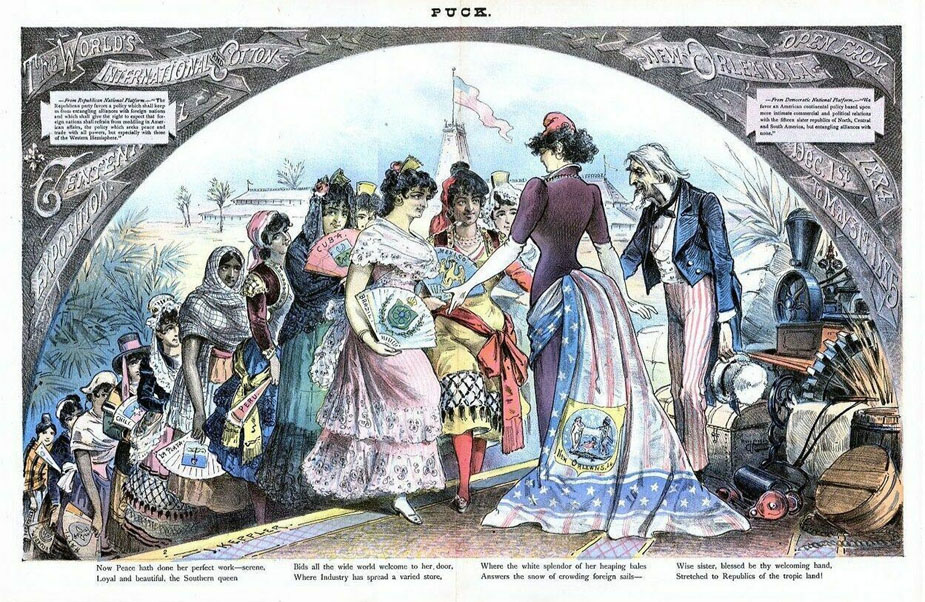
Uncle Sam and Sister Peace
Greet Visitors to the World's International Cotton Exposition in New
Orleans, Puck, December 1884.
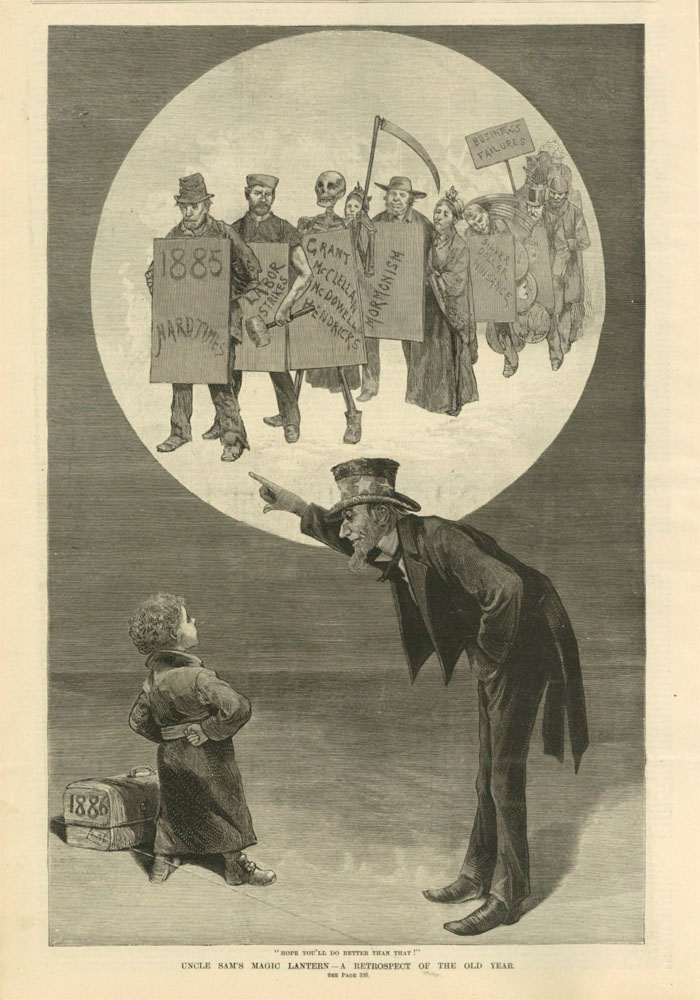
Uncle Sam hoping that 1886 will be
a better year than 1895. "UNCLE
SAM'S MAGIC LANTERN - A RETROSPECT OF THE OLD YEAR," "Frank
Leslie's Illustrated" January 1886.
Uncle Sam giving advice with an "official
proclamation" and the United States of America coin as part
of its logo, Shober & Carqueville.,1886 - Public domain, via Wikimedia
Commons (Courtesy Library
of Congress). (Disclaimer)
"Uncle Sam's Nerve
& Bone Liniment," Orcutt-Killick Litho. Co. Chicago, c. 1880s.
The name says "Uncle Sam" but little else seems connected
with its contemporary popular culture versions of Uncle Sam or Brother
Jonathan.
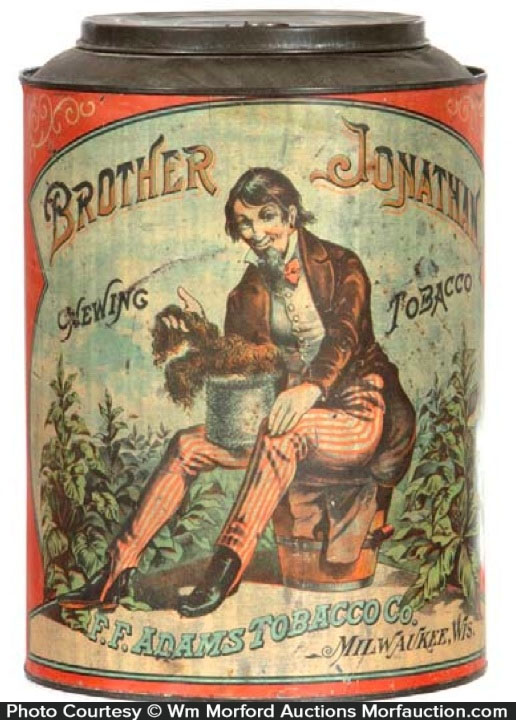
"Brother Jonathan
Chewing Tobacco Tin, F. F. Adams Tobacco Co., Milwaukee, Wis. c. 1880's?
Uncle Sam in the
1890's - The Uncle Sam Show
In 1893 Uncle Sam and Miss Columbia
represented the United States and welcomed the world to Chicago.
A role performed by Brother Jonathan in Philadelphia at the Centennial
International Exhibition of 1876 was now prominently assumed by
Uncle Sam for the World's Columbian Exposition of 1893.
Uncle Sam Promoting Hub Gore, Makers
of Elastic for Shoes
Of all the promotions which used Uncle
Sam as a salesman the World's Columbian Expostion of 1893, Hub Gore
shoes is by far the most interesting to Friends of the Phonograph
since there actually was an exhibit at the Exposition which featured
an effigy of Uncle Sam "speaking" his Hub Gore sales message
by means of an Edison Phonograph.
For that story and related details
see The Antique Phonograph's “Rest
about 10 seconds between speeches.” The Uncle Sam Mystery
at the 1893 World’s Fair by Allen Koenigsberg, March 2023.
This Beacon Lith Co. Boston trade
card showing Uncle Sam promoting Hub Gore shoes at the 1893 Columbian
Exposition with the automaton using an Edison Phonograph to "talk"
is the earliest of the four Hub Gore issued trade cards (Beacon
Lith Co., Boston, March,1894) (PM-0650)
For more examples of Uncle Sam promoting
other products at the Columbian World's Exposition of 1893 see Phonographia's
Uncle Sam and the
Columbian World's Exposition.
Uncle Sam promoting Keystone Manufacturing
Co., Agricultural Implements. Mechanical trade card, circa 1890's.
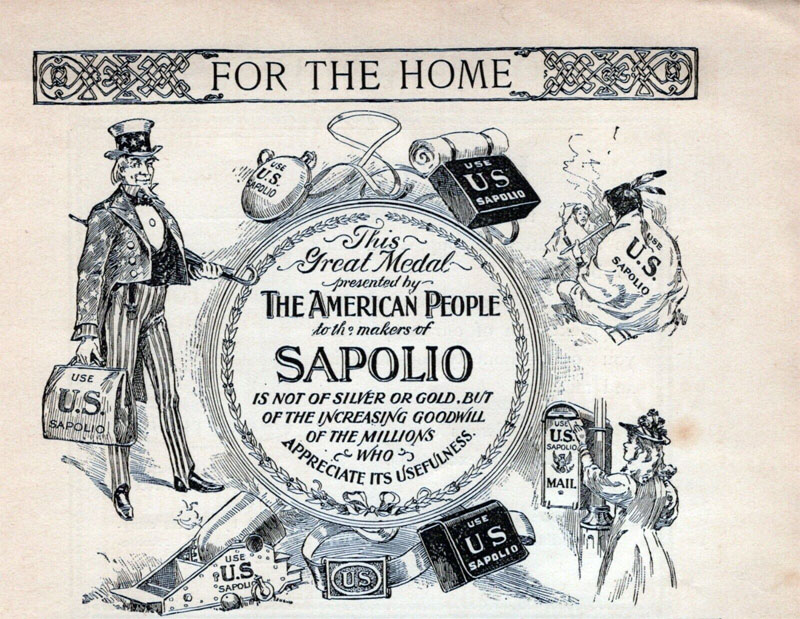
Sapolio Soap ad, 1894

Dr. Price's Baking Powder, Harper's
Weekly, 1895

Ad for Dr. Price's Baking
Powder, Omaha Daily Bee, April 30, 1895
Wheatlet Breakfast Food "Eaten
and Enjoyed by all Nations" promoted by Uncle Sam, die-cut
lithograph by Alfred von Cothausen, Milwaukee, Wis., 1899.
Daisy Hose Supporters
promoted by Uncle Sam "for rich and poor" and all nations
for Pan-American Exposition. Trade card by Compton Litho. Co.,
St. Louis circa 1901.
Card promoting Customers to order
Spring-Summer Catalog, Montgomery Ward & Co., 1897
Catalog is Free - Send 15¢
to partially pay postage or expressage
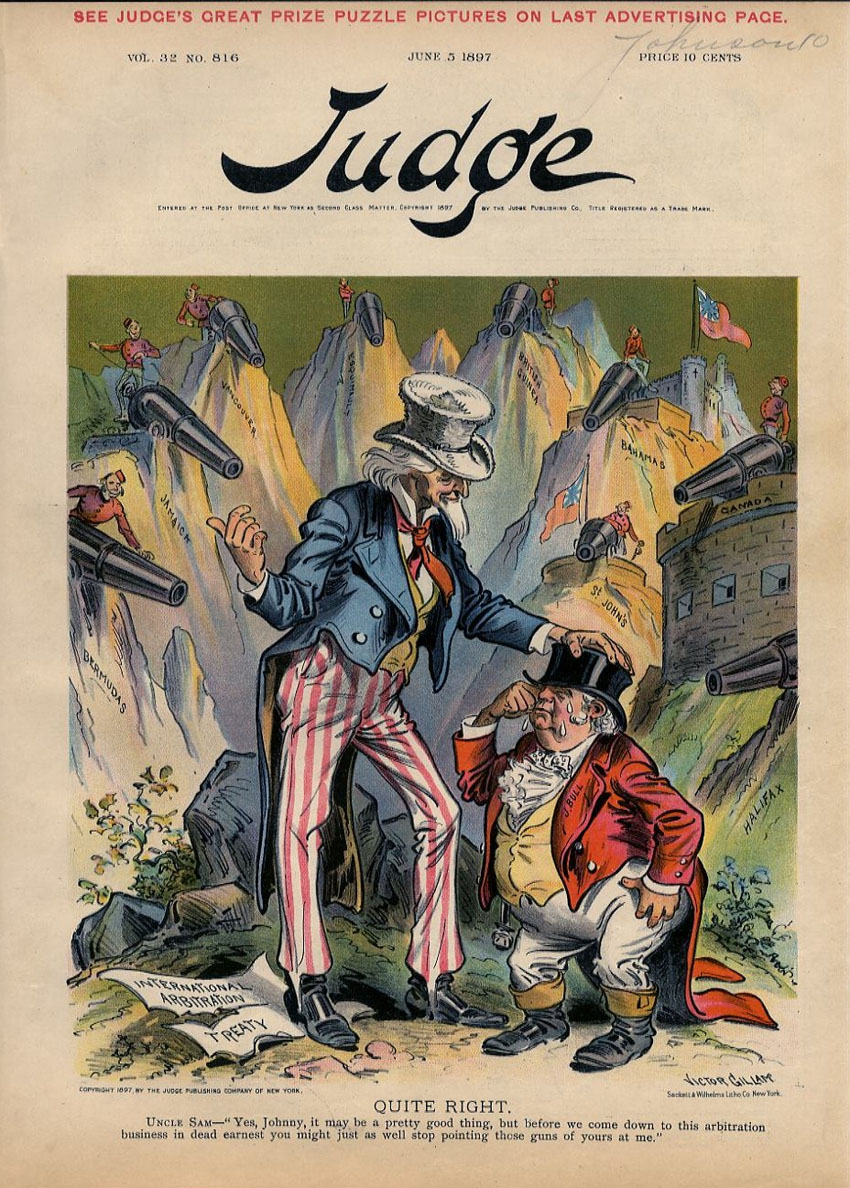
Uncle Sam and John
Bull engaging in International Arbitration, Judge, June
5, 1897
Uncle Sam sitting on top of American
goods talking to John Bull (and ready to take his money). Judge,
September 25, 1897.
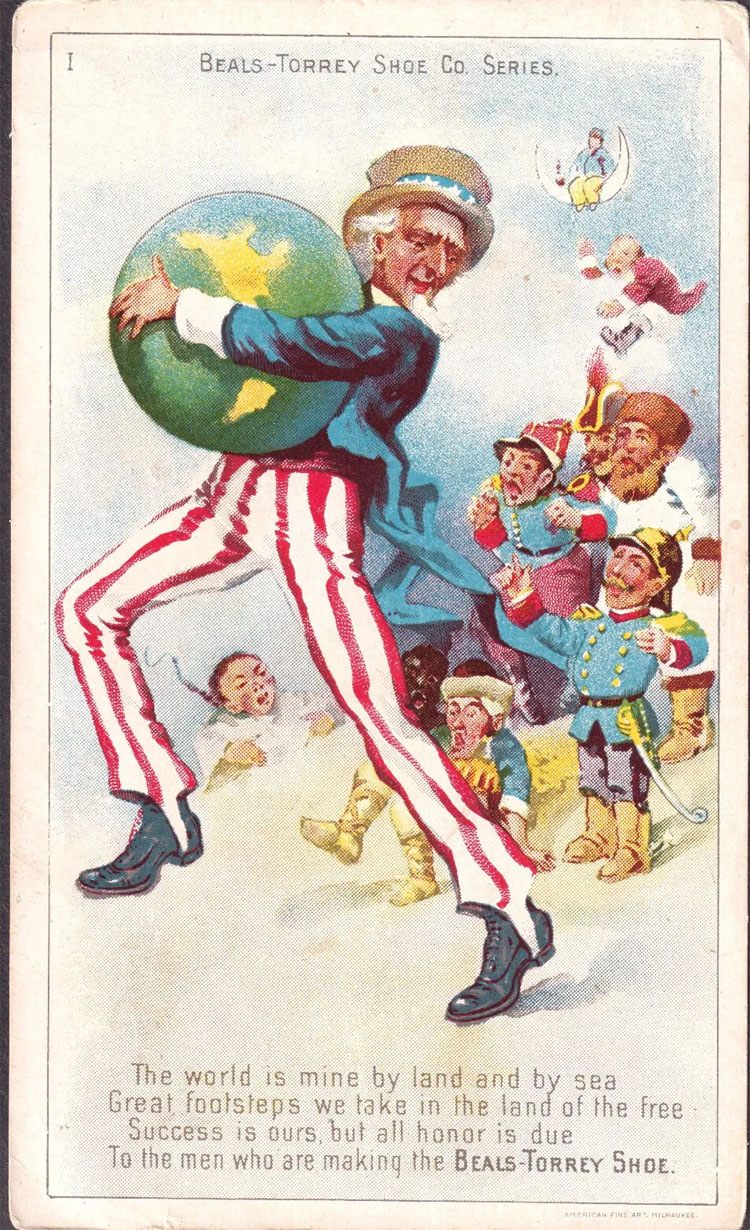
"The world is
mine by land and by sea...BEALS-TORREY SHOE. (See
Reverse).
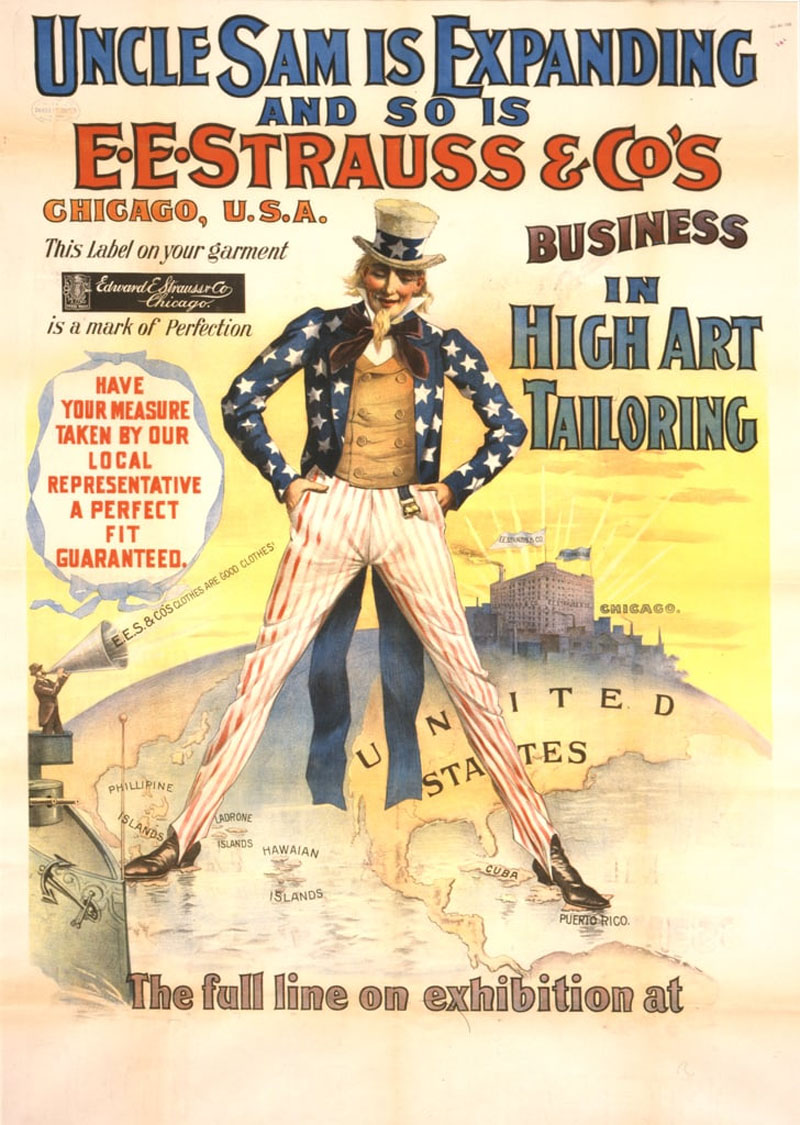
Uncle Sam and E. E. Strauss
& Co. clothes expanding circa 1899 Philippine–American War (Poster
available from Meisterdrucke)
By
1900 Uncle Sam was the face and the personification of America.
He was cartoon image and representative of the United States of
America and its government, and as has been seen, he promoted many
American products in consumer ads.
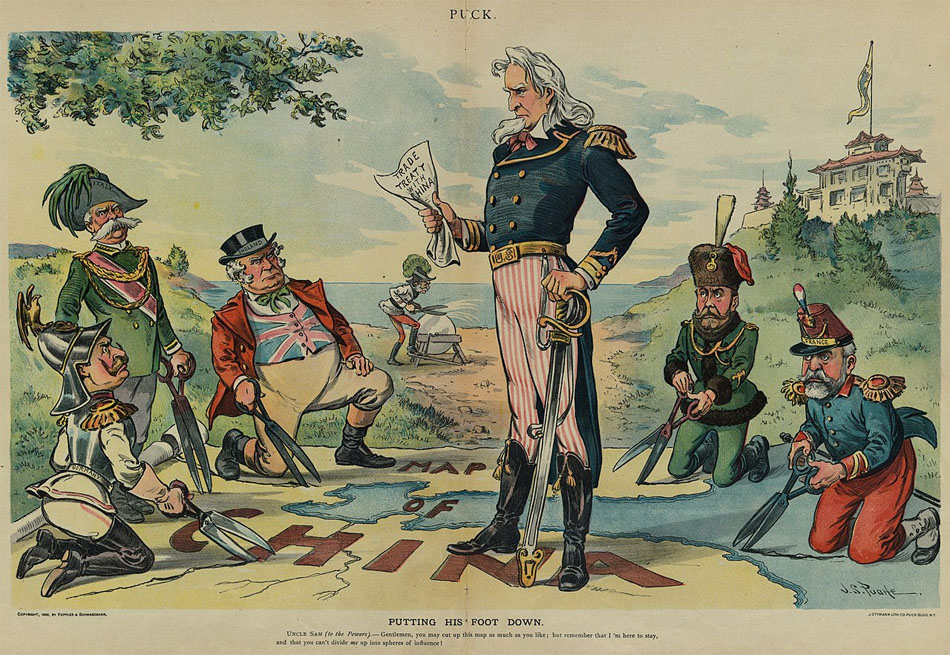
Puck, August 23, 1899, Color
lithograph by J.S. Pughe (Courtesy Library of Congress) - Uncle
Sam "Putting his foot down" with the foreign powers of
the world (including "John Bull") ready to divide China
into their spheres of influence.
Description: Uncle Sam holding a "Trade
Treaty with China", standing on a "Map of China" in the midst of
foreign rulers labeled "Germany, Italy, England, Austria, Russia
[and] France"; depicted are William II, Umberto I, John Bull, Franz
Joseph I sharpening scissors at a grinding stone in the background,
Uncle Sam, Nicholas II, and Emile Loubet, each with large scissors,
intent on cutting up the map. Uncle Sam says: "Gentlemen, you may
cut up this map as much as you like; but remember that I'm here
to stay, and that you can't divide me up into spheres of influence!"
(Library of Congress)
The Prize-Cake Walker is Old Uncle
Sam
This gallery ends the nineteenth century
with the 1899 sheet music "The Prize-Cake Walker is Old Uncle
Sam" and its disc record made by the American Talking Machine
Company in 1899. The sheet music and recording are courtesy of the
David Giovannoni Collection and i78s.org.
"The Prize-Cake
Walker is Old Uncle Sam," published by Hylands, Spencer &
Yeager, 1899.
Uncle Sam After 1900
Variations in how Uncle Sam was
depicted continued into the twentieth century until the ultimate
sales program of World War I used Uncle Sam and its "well-known
recruitment image of Uncle
Sam" created by
James Montgomery Flag.
Flag's Uncle Sam established what
could be called the "standard appearance" of Uncle
Sam for the next decades.

Uncle Sam in World War I Army Recruitment
Poster, 1917, by James Montgomery Flagg,
(This image is available from the United
States Library of Congress's Prints and Photographs division.)
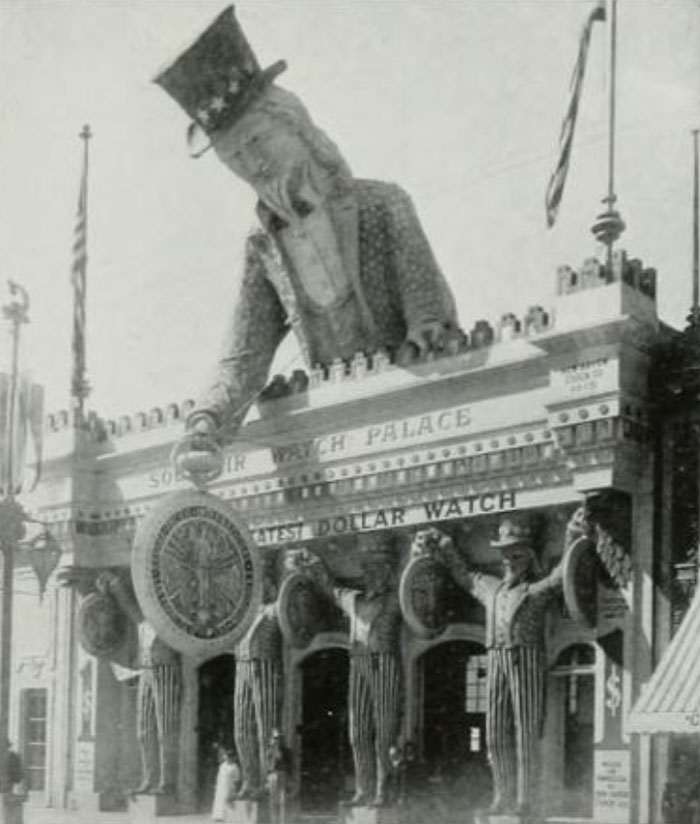
"The Souvenir Watch
Palace, presided over by Our Uncle Sam, with a counterfeit presentiment
as guardian at the door" located at the 1915 Panama-Pacific International
Exposition Zone Concessions, "The Blue Book, A Comprehensive
Official Souvenir View Book Illustrating the Panama-Pacific International
Exposition at San Francisco 1915", p. 317.
Additional Examples
and Postscript
See Phonographia's "Brother
Jonathan and Uncle Sam - Canadian Caricatures
1849 - 1878" for additional examples in Canadian
popular culture of how Brother Jonathan and Uncle Sam were seen
as documented in A Caricature
History of Canadian Politics.
See Phonographia's "Uncle
Sam and The World's Columbian Exposition" for examples
of products that Uncle Sam promoted at 1893 World's Fair.
See Phonographia's "Uncle
Sam and Brother Jonathan Illustrations
-- Frank Leslie's Illustrated Newspaper and Harper's Weekly,
1875 - 1878" for additional illustrations in popular culture
newspapers.
See American
Experience, Centennial Exposition of 1876 - From the Telephone
and Telegraph Comes the Phonograph.
See Phonographia's "Uncle
Sam Illustrations - Puck and Judge, 1880 - 1900" for additional
illustrations in popular culture newspapers.
See Phonographia's "Uncle
Sam and the Phonograph for examples of Uncle Sam seen in phonograph
ads.
See a business transaction
involving Brother
Jonathan and the Czar as a joke in The Manning Times,
January 17, 1887.
In 1890 "Brother
Jonathan's" Day was established in Connecticut with June
15 selected for its anniversary to be celebrated in Lebanon, Connecticut.
There are questions today as to the historical accuracy of the origins
of the name "Brother Jonathan," but it should also be
noted that countless newspapers for decades into the twentieth century
reported the Origin
of Brother Jonathan
as a syndicated factoid.
The book with the most Uncle Sam history,
illustrations and information for making the case that the original
Uncle Sam was based on Samual Wilson is Alton Ketchum's "Uncle
Sam: The Man and the Legend," Hill and Wang, New York, 1959.
Credits
Graphics, ephemera and popular culture
are the foundation of Phonographia's archive of phonograph connections
and stories. The following resources supported the creation of this
Uncle Sam/Brother Jonathan Salesmen gallery: The HathiTrust; The
Library of Congress; The Internet Archive; Wikipedia; Archives of
History, LLC; Newspapers.com; The Library Company of Philadelphia;
Lester S. Levy Sheet Music Collection; New York Public Library Digital
Collections, Ebay; Allen Koenigsberg, Adee Braun, David Giovannoni,
Dave Cheadle. Thank-you!
Single-sided reverse
painted and silver leaf glass sign from the American Cigar Company
of New York c. 1910 with graphic of Uncle Sam. (17" x 6").
Phonographia
|




